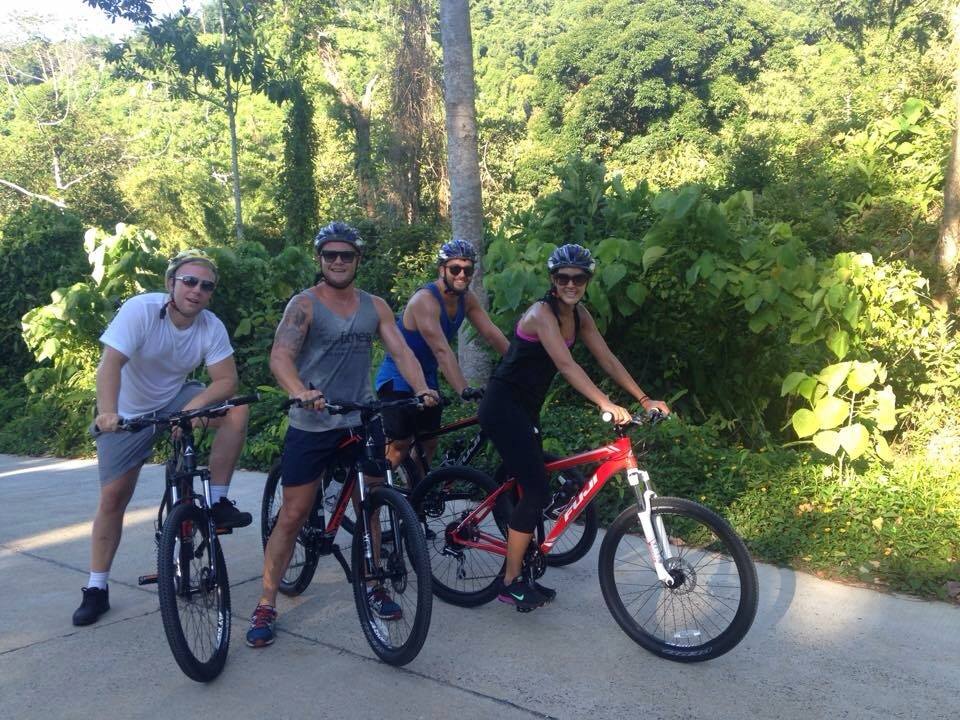One Month in Lamai
It's hard to believe that Meghan and I just finished an entire month of getting our asses kicked on Koh Samui. There were moments when it felt as if time stood still. Like when we were running 8Ks through the jungles of Samui or trying to finish a modified Murph[^n] after an hourlong of "warmup" of clean and presses, deadlifts, and hill sprints. But aside from that, the month of August flew by and we feel amazing.
Lamai
We spent August in the Lamai neighborhood of Koh Samui. As a refresher, Lamai is the second-most popular destination in Samui, located on the southeastern side of the island.
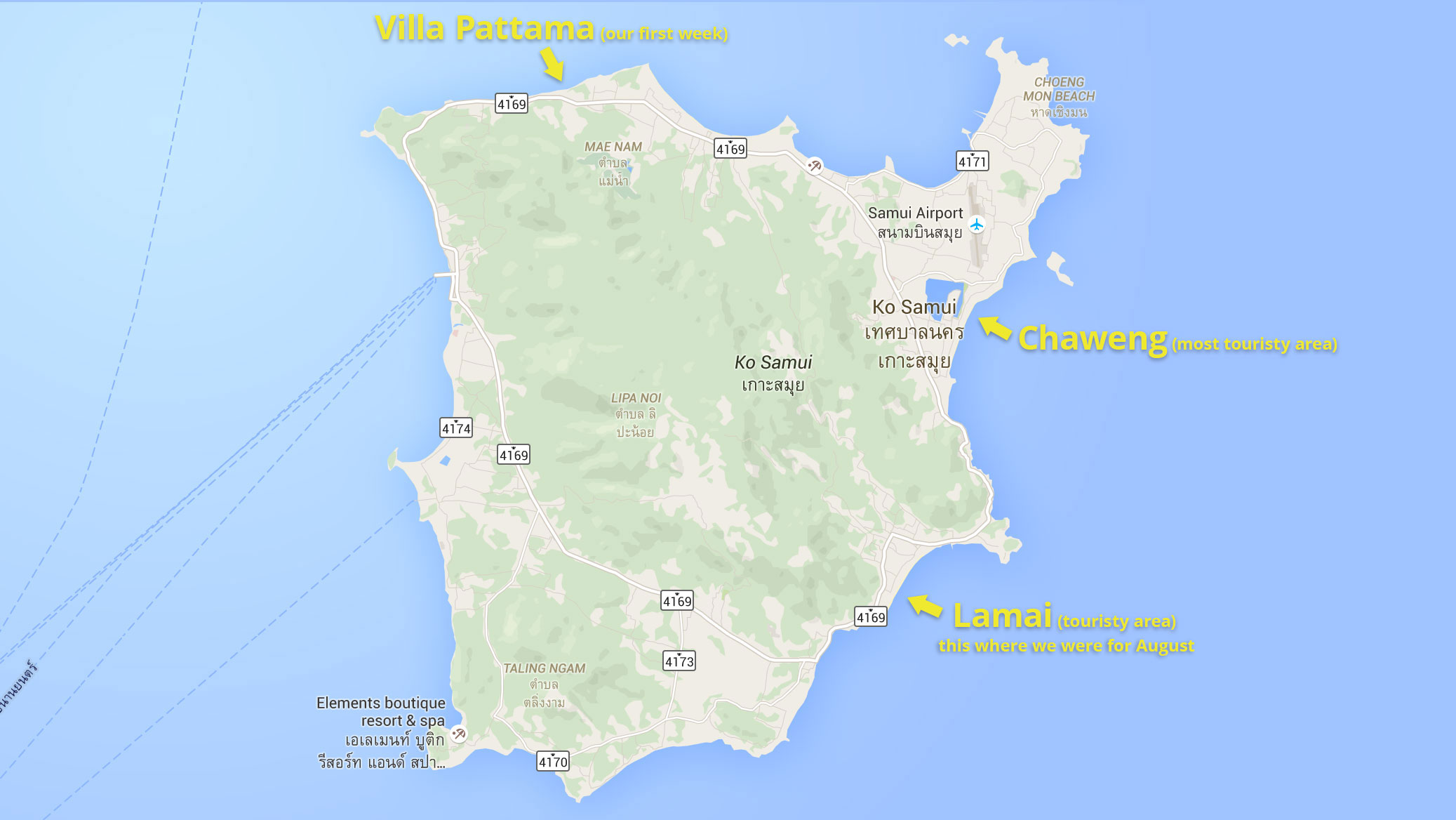
Some of you might be wondering, "Why would you guys spend an entire month in a touristy neighborhood??" Well, one of our objectives for this sabbatical is to get into the best shape of our lives, working out wherever we find ourselves. While in Samui, we thought this might entail some running or maybe going to a gym or a Crossfit box. In searching for such a facility, we discovered a place that takes the concept of "getting into shape" to a whole new level.
Lamai Fitness
Lamai has an unmistakable fitness culture: there are Muay Thai camps and gyms all around, groups of athletes running alongside the road, restaurants serving sugar-free smoothies and steamed fish and vegetables, and so forth. I don't know this for sure, but if I had to guess, this culture probably originated with Muay Thai.
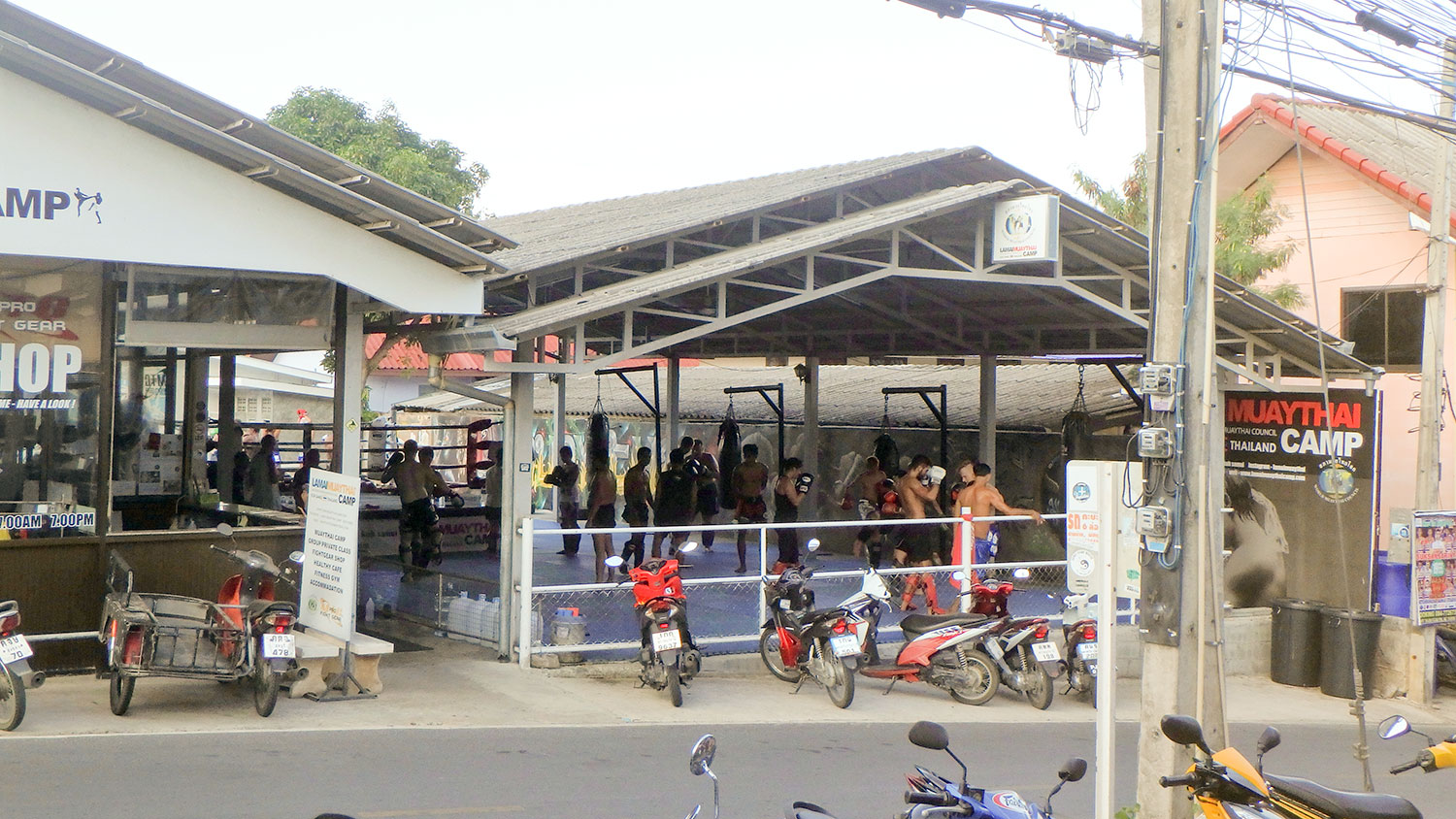
Lamai Muay Thai Camp across the street from where we worked out. During our stay, the Ukranian, Kazak, and New Zealand national teams trained here in preparation for some international Muay Thai competition.
An integral component of this local fitness community is Billy Orr and his facility, Lamai Fitness.
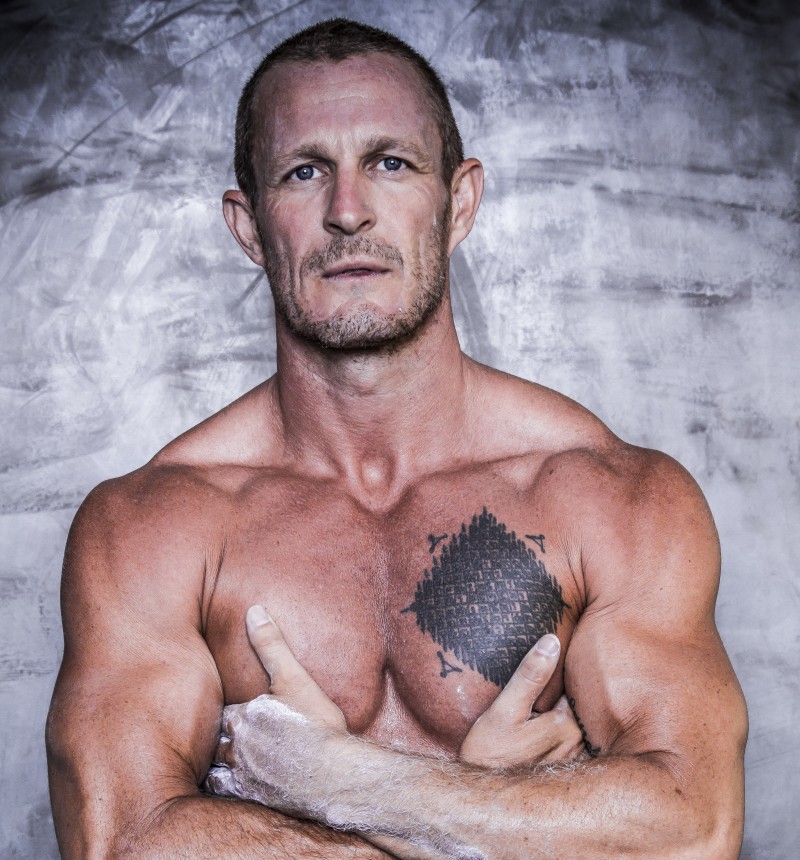
Stock photo from the website, not representative of Billy's affable personality
Billy is a genial British expatriate who loves fitness. Loves fitness. Normally when you see a trainer working with a client in the gym back home, he's standing there, checking his iPhone, sipping a latte, occasionally having his client do a sit-up or something during the pauses in their conversation. Not Billy. He's there right alongside you the entire time (or more accurately, right in front of you). It doesn't matter if it's running 13 kilometers through the jungle, cycling 50 kilometers over and around the island, swimming 4 kilometers in open water, or clean and pressing 5 sets of 20 reps. He does this all day long and, like I said, he loves it.
Athletes typically come to train with Billy in bootcamp fashion, immersing themselves for anywhere from two weeks to nine months. His clients run the gamut from elite triathletes preparing for an Ironman (this was Billy's personal passion at the moment) to Biggest Loser-style life transformations. He gets incredible results using a combination of intense workouts, clean nutrition, and an exceptionally positive environment filled with camaraderie.
We met Billy in late July and saw an opportunity for a challenging, but rewarding experience that'd never be available to us in the "real world." So we decided to go for it. We committed to four weeks of daily double sessions, bootcamp-style.
Programming
The basic exercise protocol consists of working out twice a day for two hours each weekday. The morning session typically involved of some form of longer distance cardio, be it running, swimming, or cycling, followed by some metabolic conditioning back at the gym. This metcon was generally progress towards completing the "daily challenge" which changed every week. The afternoon session typically alternated between (i) an hour of intense cardio followed by strength training and (ii) an hour of moderate strength training followed by a Crossfit-like WOD. Of course, this is always subject to change.
Here was my second week. The figures represent what I was able to complete, not what was prescribed.
| Monday | |
|---|---|
| Morning (first part) | 4 x 2K runs, timed |
| Morning (second part) | Seven rounds: - 1 minute ropes - 1 minute plank - 10 incline sit-ups |
| Afternoon (first part) | Bench press pyramid: - 1 x 50 reps (20 kg) - 1 x 40 reps (40 kg) - 1 x 30 reps (50 kg) - 1 x 20 reps (60 kg) - 1 x 10 reps (70 kg) - reverse *significant assistance |
| Afternoon (second part) | Murph: - 2K run - 100 burpees - 200 incline sit-ups - 300 squats *couldn't finish sit-ups |
| Tuesday | |
|---|---|
| Morning (first part) | 1.7K open water swim |
| Morning (second part) | Four rounds: - 1 minute ropes - 1 minute plank - 10 incline sit-ups |
| Afternoon (first part) | Clean and presses: - 6 x 15 or 20 (20 kg to 50 kg) Deadlifts: - 3 x 10 (50 kg to 70 kg) |
| Afternoon (second part) | Six rounds: - 1 minute ropes - 1 minute plank - 10 incline sit-ups |
| Wednesday | Morning (first part) | 9K run |
|---|---|
| Morning (second part) | Four rounds: - 1 minute ropes - 1 minute plank - 10 incline sit-ups |
| Afternoon (first part) | Barbell curls superset: - wide/middle/inside grip - 3 x 20 each grip (bar) 10 hill sprints 3 x 10 tricep pushdown 3 x 10 cable curl 10 mins bike *hurt foot earlier[^n] |
| Afternoon (second part) | Five rounds: - 10 bench press - 10 kettlebell swings (24 kg) - 10 pull-ups *needed assist Five rounds: - 1 minute ropes - 1 minute plank - 10 incline sit-ups |
| Thursday | Morning (first part) | 3 x 500m open water swims 2 x 75m sprint swims + beach sprint |
|---|---|
| Morning (second part) | Five rounds: - 1 minute ropes - 1 minute plank - 10 incline sit-ups |
| Afternoon (first part) | 3 x 20 landmine shoulder press 3 x 5 slow count landmine shoulder press 100 dumbbell press (12 kg) 35 dumbbell press (14 kg) |
| Afternoon (second part) | Ten rounds: - 10 deadlifts (60 kg) - 10 high step-ups Five rounds: - 1 minute ropes - 1 minute plank |
| Friday | Morning (first part) | 30K bike |
|---|---|
| Morning (second part) | 30K bike (continued) |
| Afternoon (first part) | 8K run *couldn't complete with foot |
| Afternoon (second part) | Leg superday: - 3 x 10 smith machine squat (bar to 40 kg) (one half and one full equal a rep) - 3 x 20 stiff-legged deadlift (bar) - 3 x 20 leg press (100 kg) - 5 x 20 dumbbell squat / air squat superset - 3 x 20 rope squat Core work |
I have never done so much volume in my life. The experience has certainly recalibrated my definition of fitness. Back home, a workout in the gym might consist of a couple sets of 5 to 12 reps on 5 to 10 exercises. Maybe I'd run or row for 20 to 30 minutes on an off day. Essentially, I subscribed to the minimum effective dose dogma popularized in recent years by the likes of Tim Ferriss and other internet gurus. If I visited the gym consistently in this way, I might be able to "hack my body" and put up more weight, lose some pounds, and pack on some muscle mass. But minimum effective dose is nonsense. Those short workouts will never develop the kind of functional fitness practiced in Lamai. This is the kind of fitness we now aspire to.
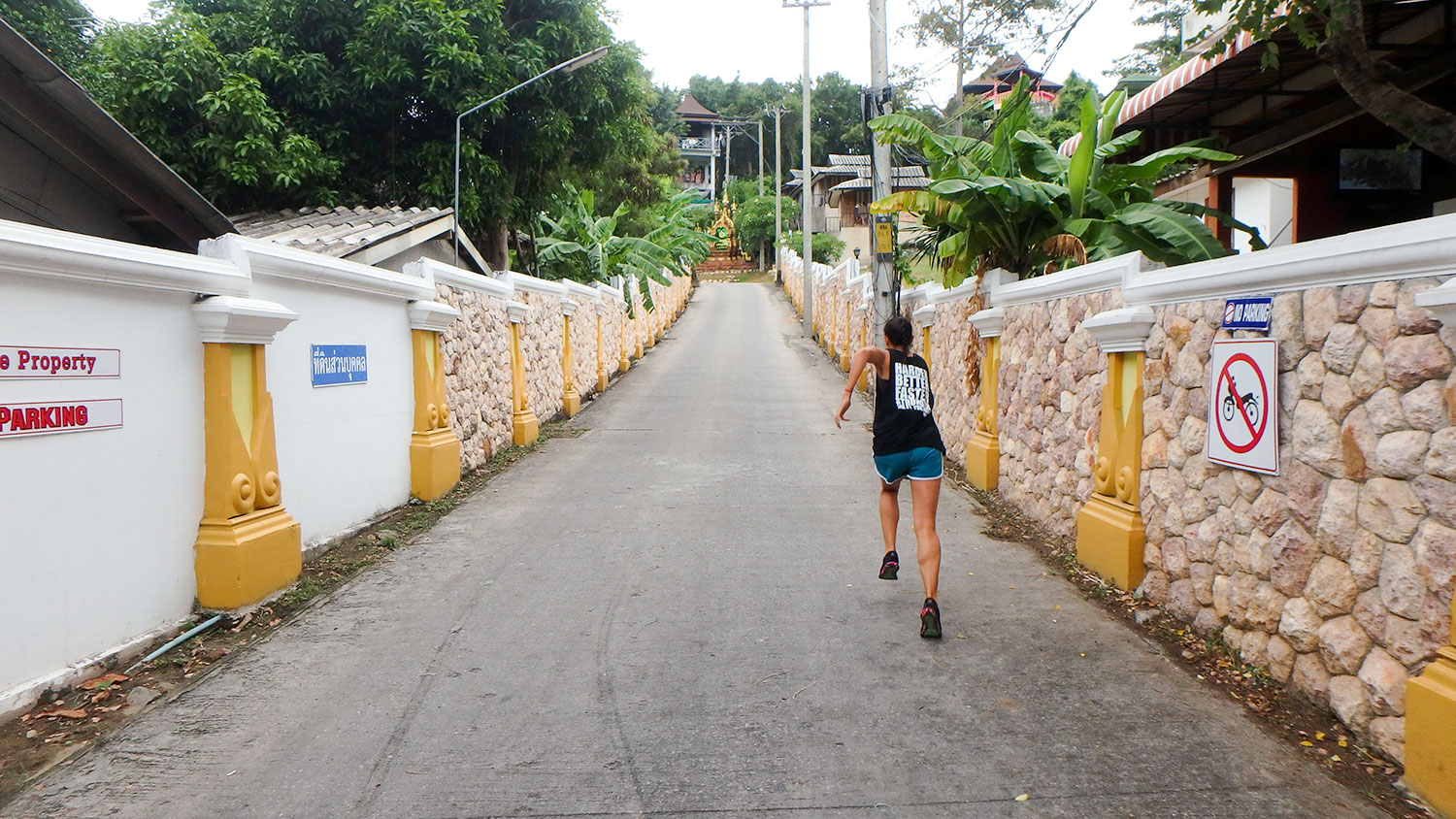
The dreaded "hills." Step one: sprint up.
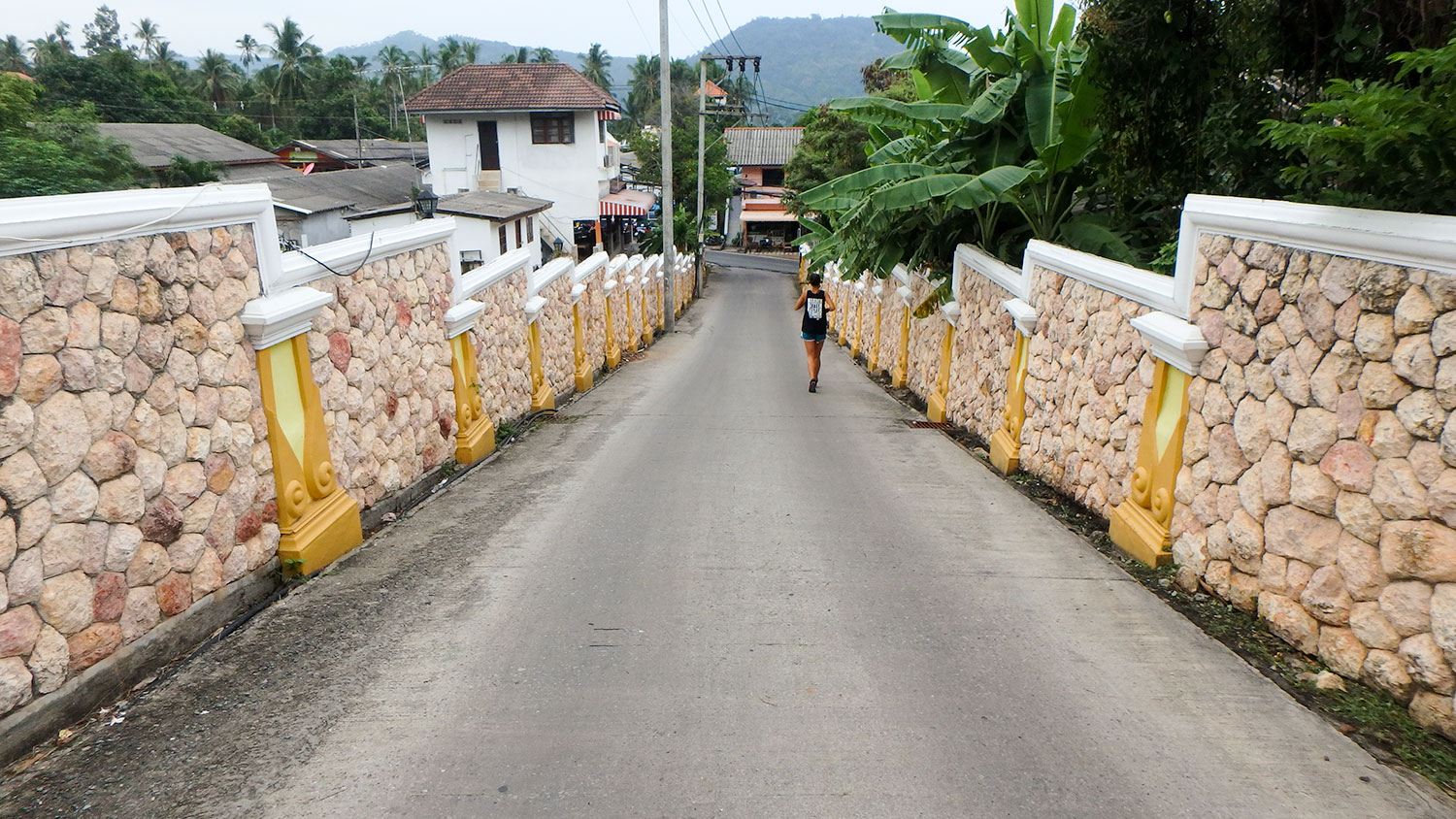
Step two: walk or jog down. Step three: repeat five to twenty-five times, depending on the workout. The second worst thing in the world.[^n]
Taking a break at the top of a massive hill
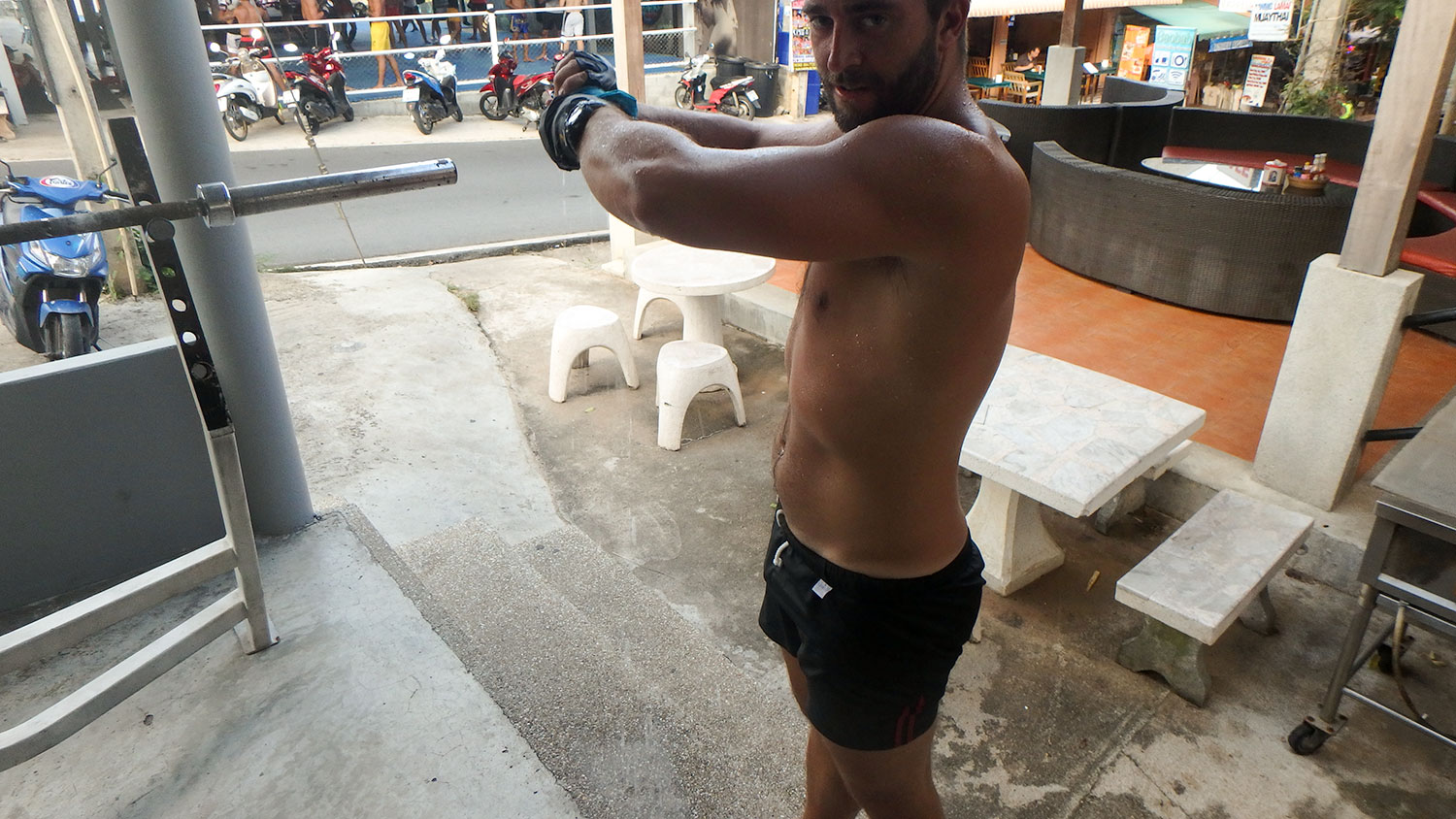
If you look closely, you can see the puddle of sweat I've wrung out from my shirt, halfway into an afternoon session. I could drink 2 liters of water and sweat the same during these workouts.
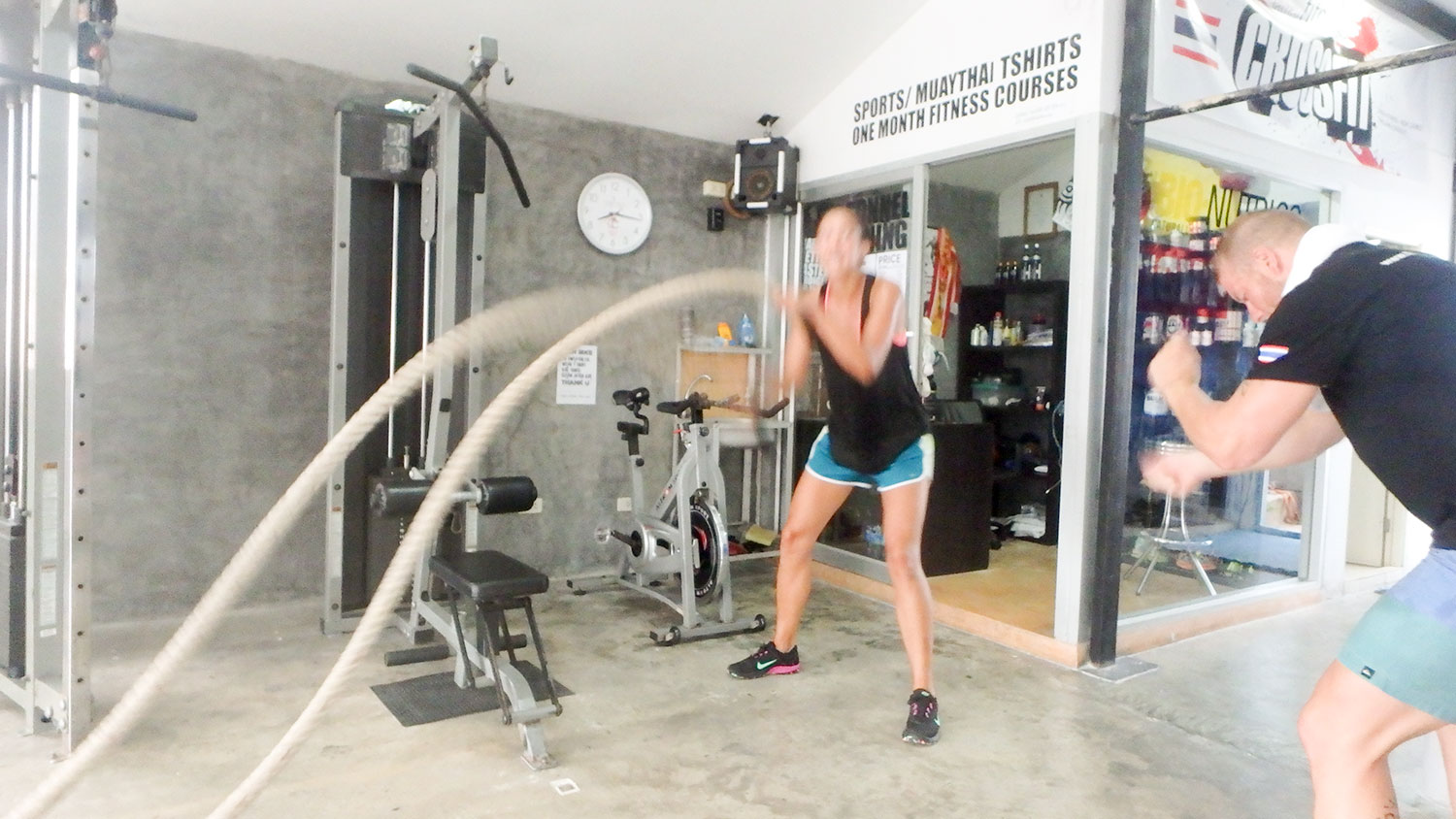
Meghan on the ropes with a little coaching from Mike. If you think the ropes look easy, I encourage you to give them a try and see for yourself.
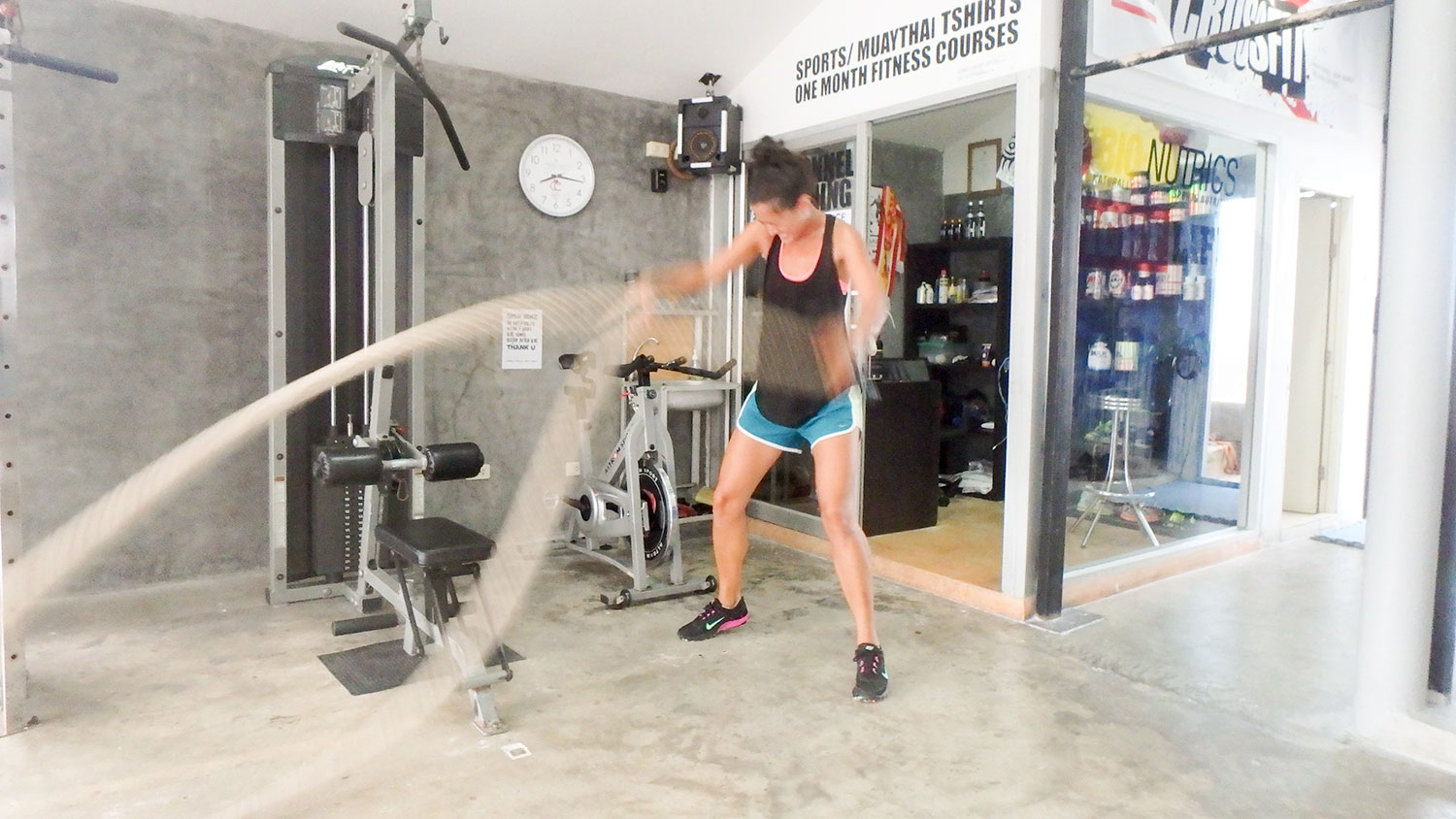
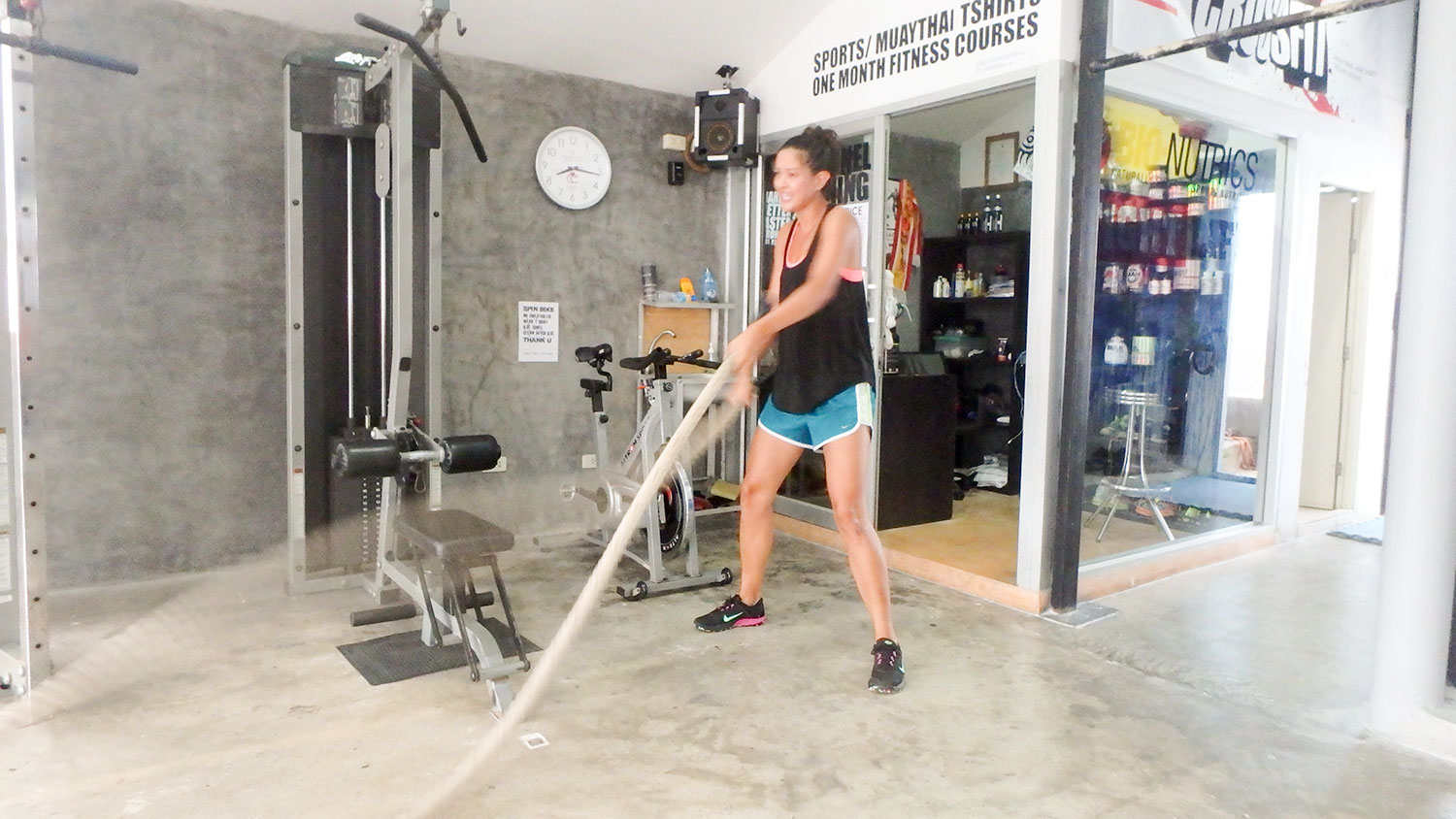
Meghan and I like to think that we really lucked out in terms of timing. Our first two weeks were spent with a few other people, so we were able to enjoy a sense of community and camaraderie during the most difficult phase of the training. Our last two weeks were more or less just me, Meghan, Billy, and Mike (Billy's assistant coach), meaning that we essentially received three or four hours of personal training a day.
Nutrition
In addition to the intense workouts, we also committed ourselves to eating super clean per Billy's protocol. I'd describe the regimen as "paleo supplemented with some starches and a tremendous amount of fruit." Although our meals were very simple and repetitive, we found them wholesome and delicious. Breakfast was poached eggs and fruit; lunch was meat or fish, rice or sweet potato, raw vegetables, and fruit; dinner was meat or fish, rice or sweet potato, steamed vegetables, and fruit; and snacks were fruit.[^n]
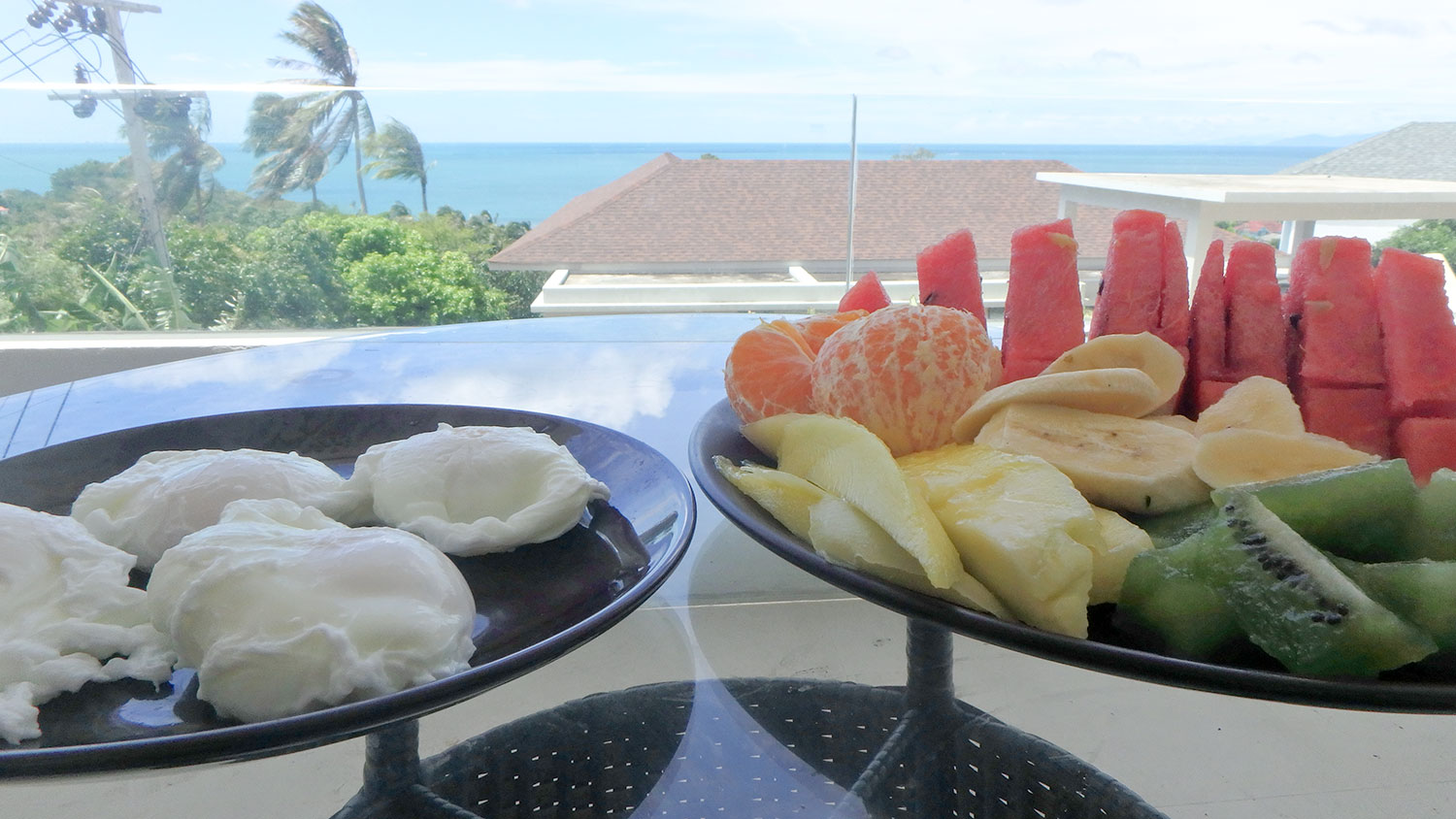
Typical breakfast: six poached eggs and fruit
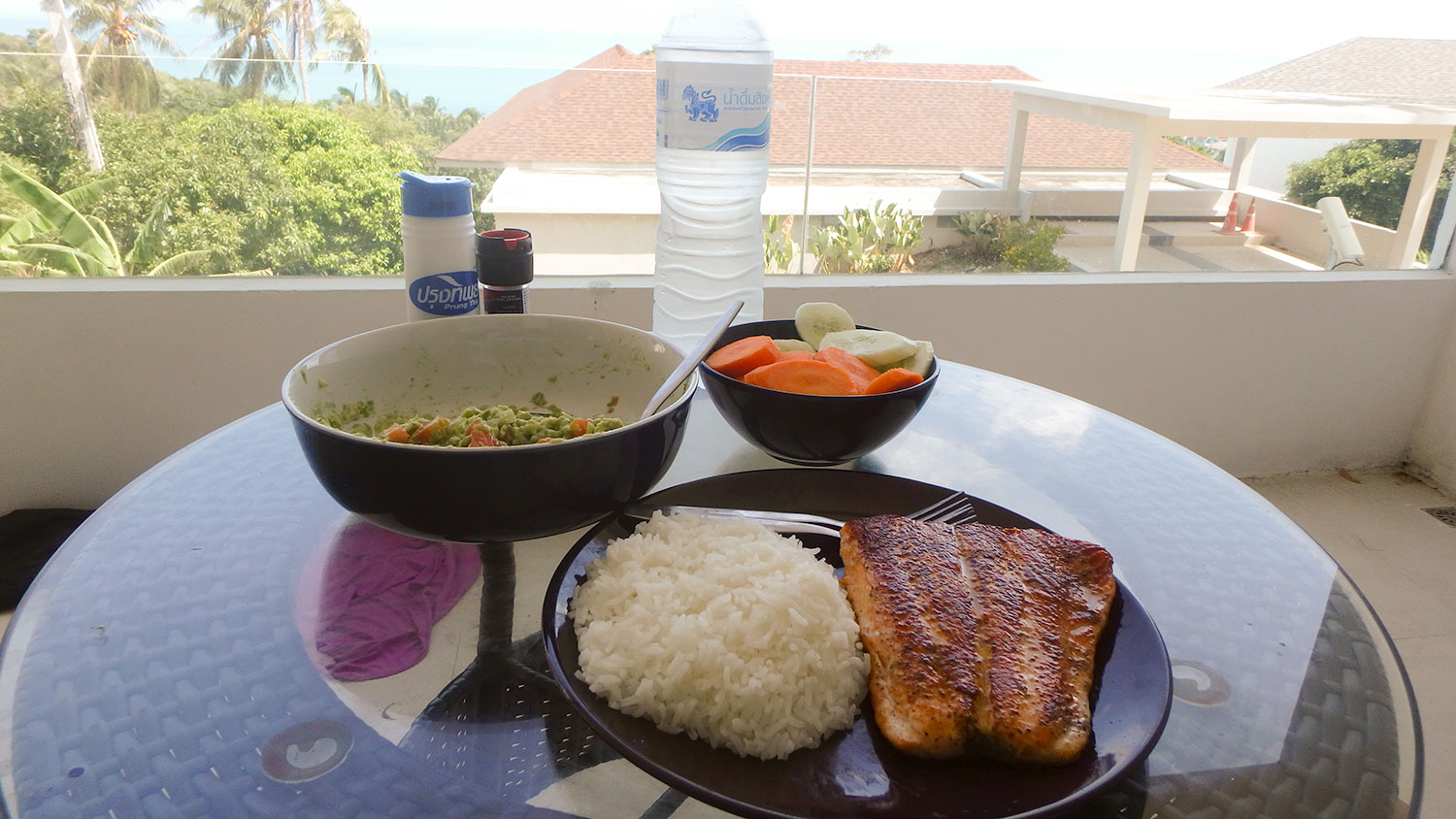
Typical lunch: salmon or tuna filet, vegetables, and a starch. We made homemade guacamole once, pictured here, but the avocados were too expensive to justify.
Oh yeah, we haven't had an alcoholic beverage in over a month either.[^n]
Given Meghan's self-proclaimed love of food, I never imagined that she would get through the month with such equanimity. Particularly since we weren't allowed to eat any cheese, chocolate, or ice cream. But she powered through with grace. Our apartment had a kitchen and we were located next door to Lamai's nicest food store which made adherence much easier than if we had to eat out every meal. Our only "treats" during this entire time -- fully endorsed by Billy, I should mention -- were all-fruit smoothies after the afternoon workout to cooldown and a chocolate milk as a post-workout recovery drink after long distance running, swimming, or cycling (happened two or three times). Meghan almost floated to 7-11 when she first learned we were allowed a chocolate milk after a 48 kilometer bike ride.[^n]
A quick side note on the food store we visited everyday: it's a classic example of the battle between new and old, of nostalgia versus capitalism.
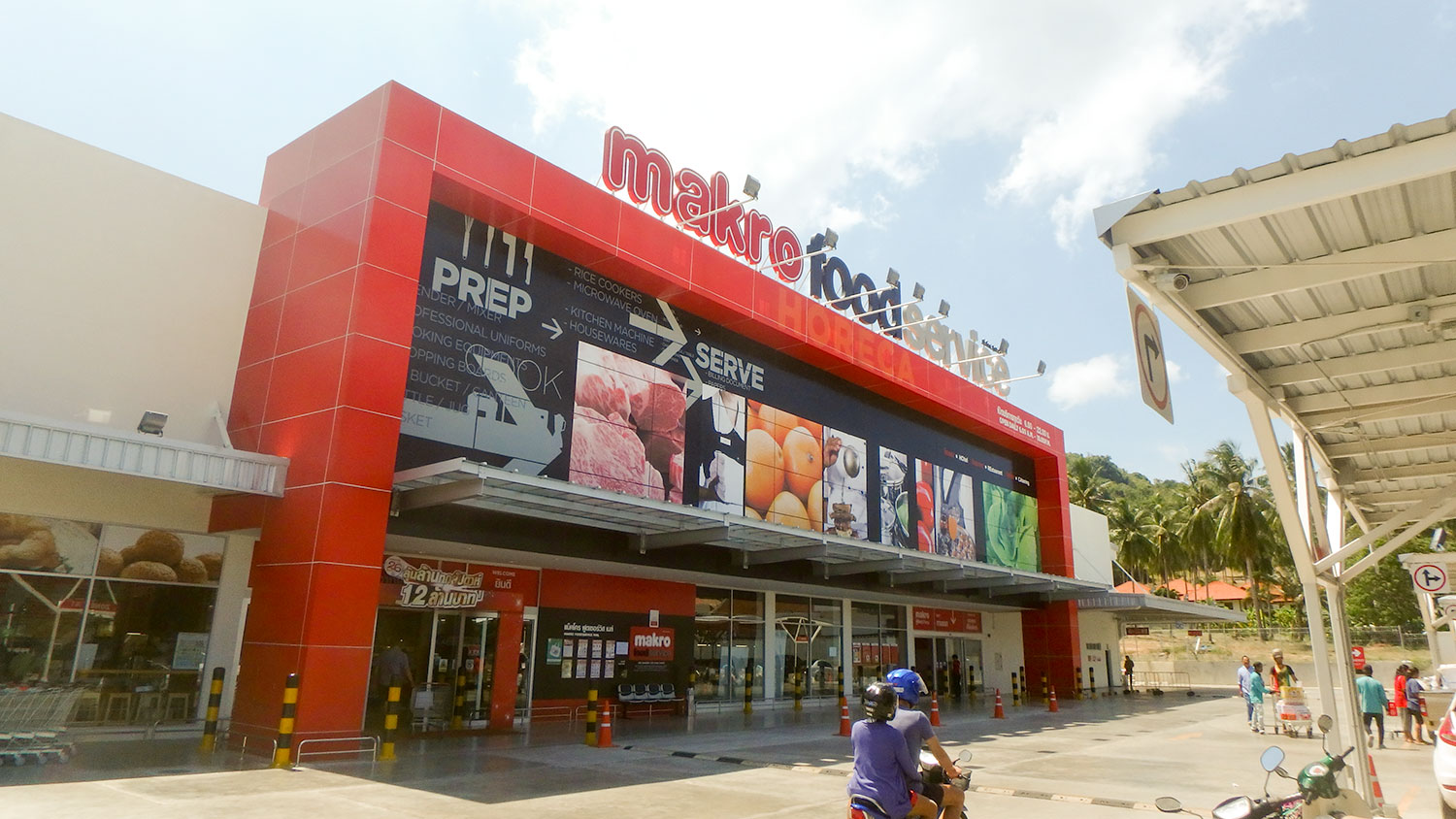
The store is called Makro and this location next to us opened less than a year ago. It has a similar feel inside to a club store in the States. On one hand, it's great to have a wide selection of high-quality produce, fish, and meat, inexpensively-priced, all in one place. On the other, it's existence makes daily visits to the Asian markets obsolete. We heard that after opening, the market vendors simply acquired their inventory from Makro. Why would we travel to a morning market when the prices, freshness, and selection were superior just next door? We wanted to fulfill a romantic fantasy of shopping everyday in the morning markets, thinking that would be a more authentic Asian experience, but it just made no sense given our options.
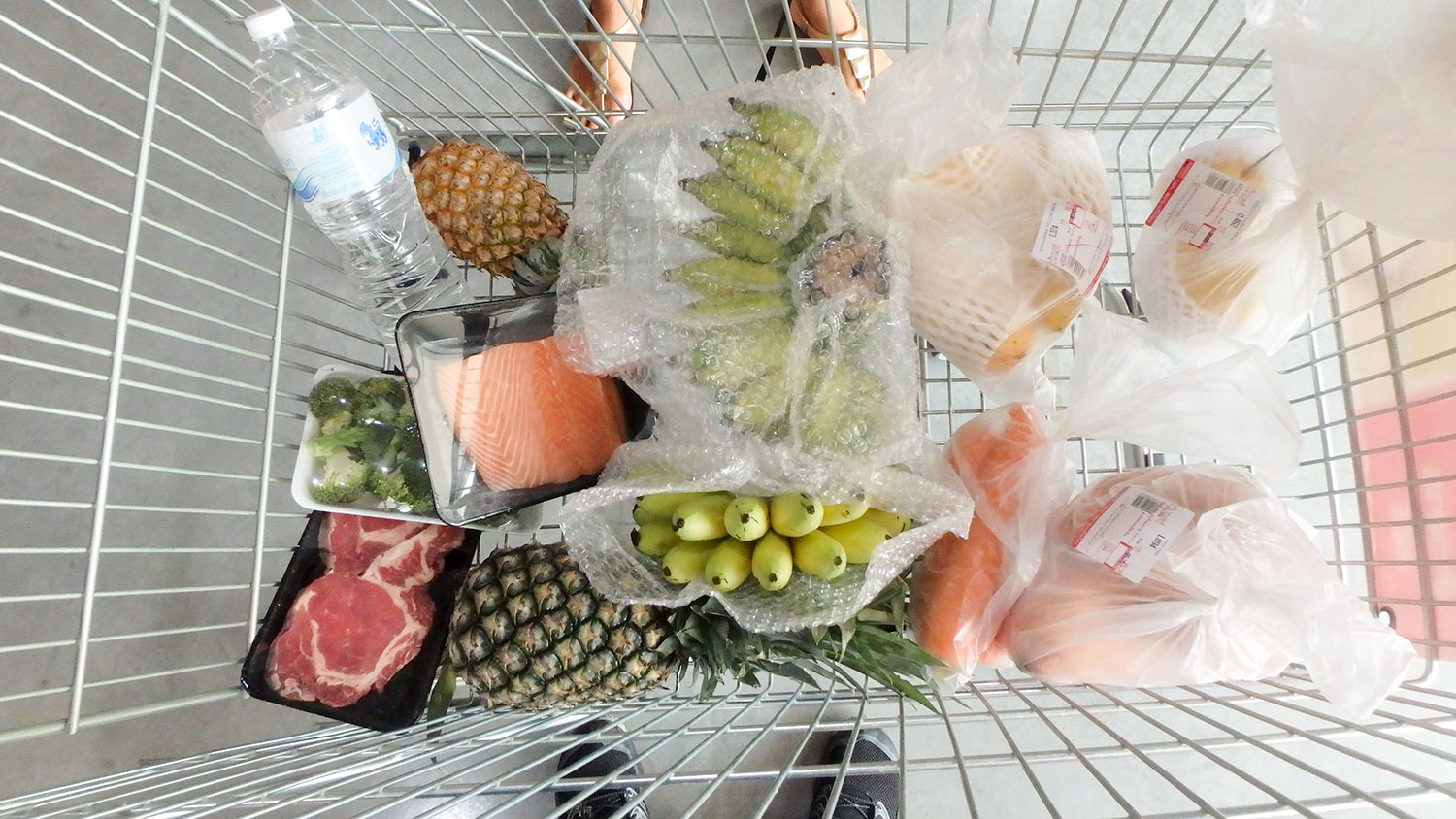
Typical daily cartload of fruit, fish, meat, and veggies
Fruit
Did I mention we ate a lot of fruit? We took our fruit consumption to Steve Jobsian proportions.[^n]
I know "fruit" might not be the most adventurous travel topic, but it was such a significant part of our day-to-day experience that I'm going take a little detour here to discuss it. It's actually a long detour, so if you have a short attention span, you might want to skip ahead. I know our moms are all about tropical fruit, so I take solace in the fact that a small, but important constituency of our audience will enjoy this section.
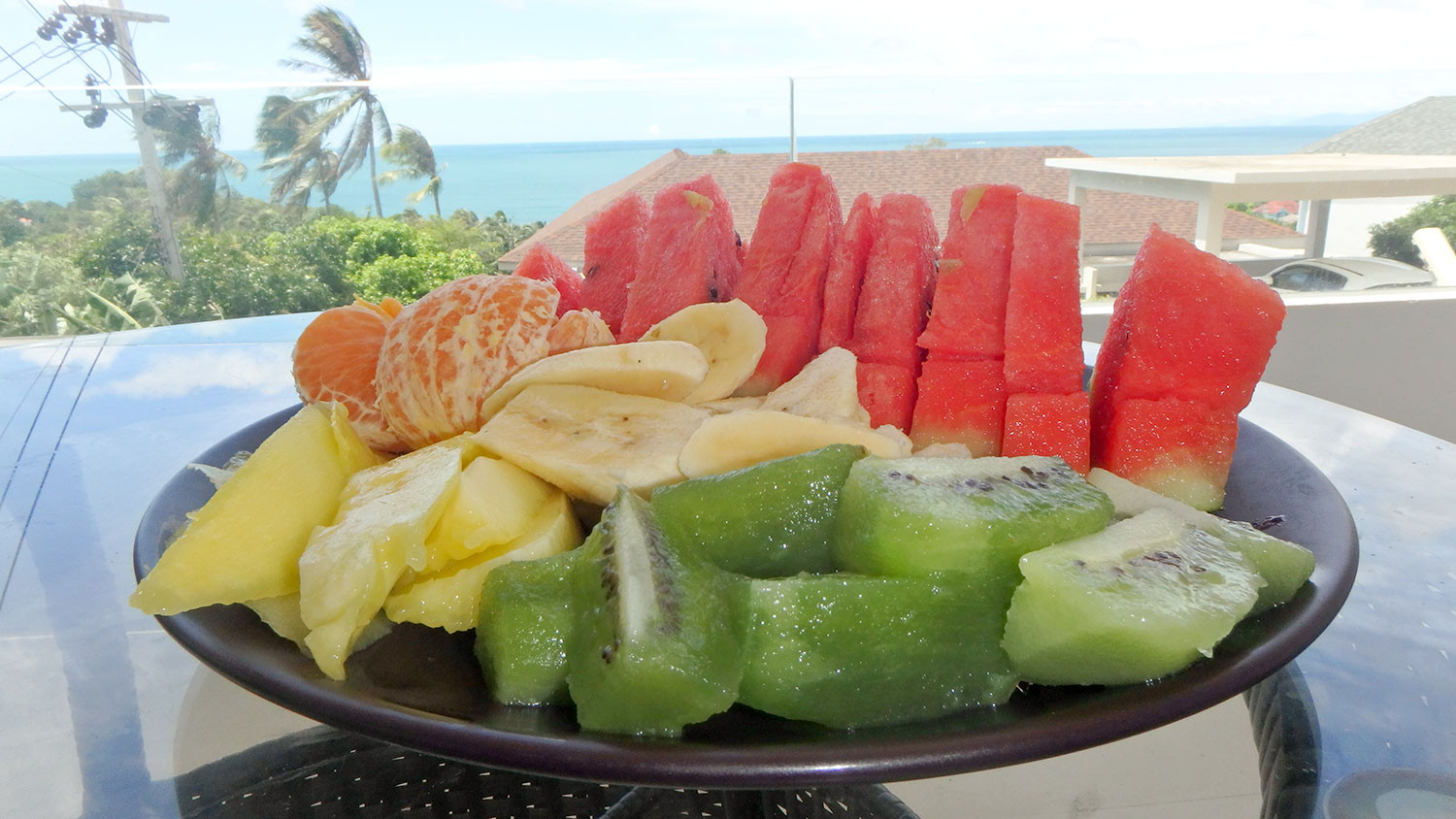
Approximately one-fifth of our average daily fruit consumption
Our staple fruits were pretty much the same you can get in the United States, except our experience of them was enriched by a heightened awareness. When you live as simply as we did this past month, the mundane suddenly becomes interesting.
Watermelons
Watermelon was our go-to fruit. Nothing beats a cold watermelon after a grueling workout. We would typically eat one watermelon per day between us -- a quarter with breakfast, a quarter with lunch, and half after dinner. There were a couple gimmicky varietals like a yellow watermelon, but we stuck to the basic cultivar down here called kinnare. It was inexpensive ($1 to $2 for a medium melon) and grown locally.
The only other thing I have to say about watermelon is with regards to its seeds. Like any kid, I spit the seeds out, afraid that one might sprout in my stomach. Somewhere along the way, I learned that just chomping into the watermelon and eating the fruit, seeds and all, was such a better experience. Meghan has not seen the light. She laboriously picks and spits out each seed. I can't convince her otherwise. Can someone back me up here?
Pineapples
Pineapples were another locally grown, inexpensive ($1) staple. There were three cultivars sold in Makro: pattavia, tard sri thong, and sriracha. Despite the positive association with the name, the sriricha was our least favorite. We found the pattavia to be best, particularly when very ripe. You can eat pineapples the same day you buy them, but if you let them ripen, they become distinctively sweeter and juicier. The flesh of a ripe pineapple takes on a deep yellow translucency instead of a pale yellowish opacity. Judging the ripeness of a pineapple is difficult, however. You have to pay attention to the subtle color change between the scales -- the color there changes from greenish to gold as it ripens.
Oranges
Makro sold a variety of oranges including a locally grown variety with a green rind, called shogun, as well as the navel and murcott varieties imported from Australia. We loved the honey murcotts and were eating 3 to 4 per person per day by the end.
Bananas
As some of you know, I have a commercial interest in bananas, making it my favorite fruit on an intellectual level. I was therefore very excited to begin my fieldwork on the musa acuminata in its birthplace.[^n]
There are supposedly a hundred varieties of banana cultivated in Thailand, but I saw only three during my stay on Koh Samui: hom, namwa, kai. These are the phonetic representations of Thai words, so the exact spelling will vary from source to source.
The hom banana is the most popular, similar to the cavendish cultivar we eat in the United States.[^n] The flavor, consistency, and sweetness are approximately the same. The only differences I noticed were a slightly smoother texture, much larger hands, and smaller fingers.[^n] The namwa banana is smaller and slightly less sweet making it less popular than the hom. The kai is even smaller, miniature in size, without a special enough flavor to compensate for its wimpy stature.
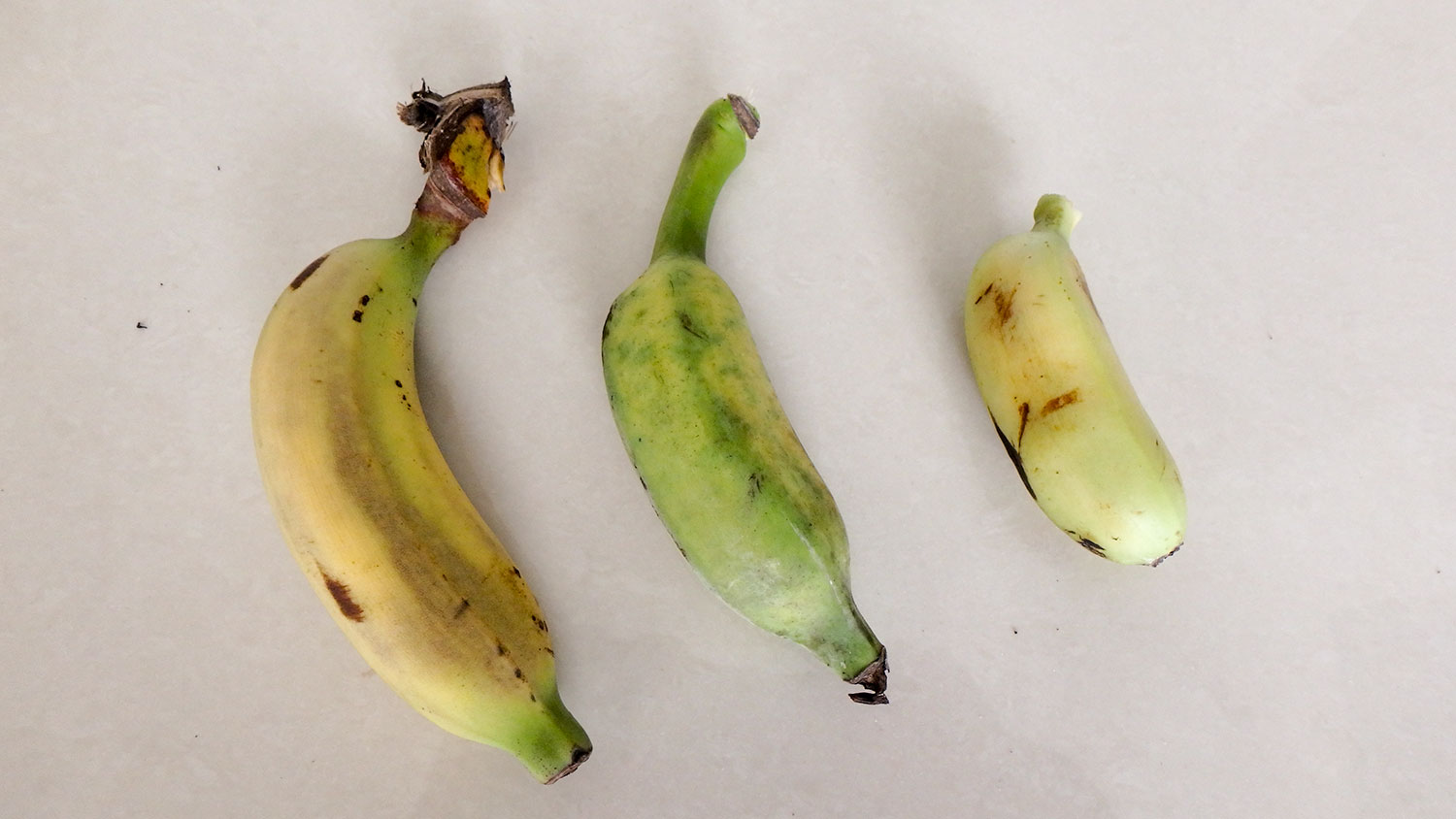
Left to right: hom, namwa, and kai bananas
Unfortunately this first month of fieldwork did not yield any significant banana breakthroughs yet. But stay tuned. We have many other countries to visit in Southeast Asia and I'm not leaving without a banana discovery.
Exotic Fruits
I wish I could say that we discovered some exotic tropical fruit with life-changing properties. No such luck. We did experiment with many of the tropical fruits indigenous to this area though.
Spoiler alert: although it is sold everywhere, we weren't adventurous enough to try durian.
The most prolific local tropical fruit is the rambutan because it's native to this area of Thailand and grows everywhere. It has a hairy red exterior, needs to be cracked open, and tastes kind of like a skinless grape. Not my favorite.
Another common tropical fruit is the longan (also known as "dragon eye"). It has a hard brown exterior, needs to be peeled, and tastes like grape mixed with cantaloupe. The dragon eye name refers to the fact that the peeled fruit looks an eyeball with a black spherical seed. Also not my favorite.
Then you have the mangosteen. This guy looks like a weird, tiny round eggplant from the outside. It needs to be pried open, and the white vesicles extracted. The mangosteen is the closest thing we found a superfruit. The flavor is complex and hard to describe, but the closest comparison I can think of is very sweet lychee with a smoother texture. That description doesn't really do the fruit justice, however. My advice is to try mangosteen for yourself if you ever have an opportunity.
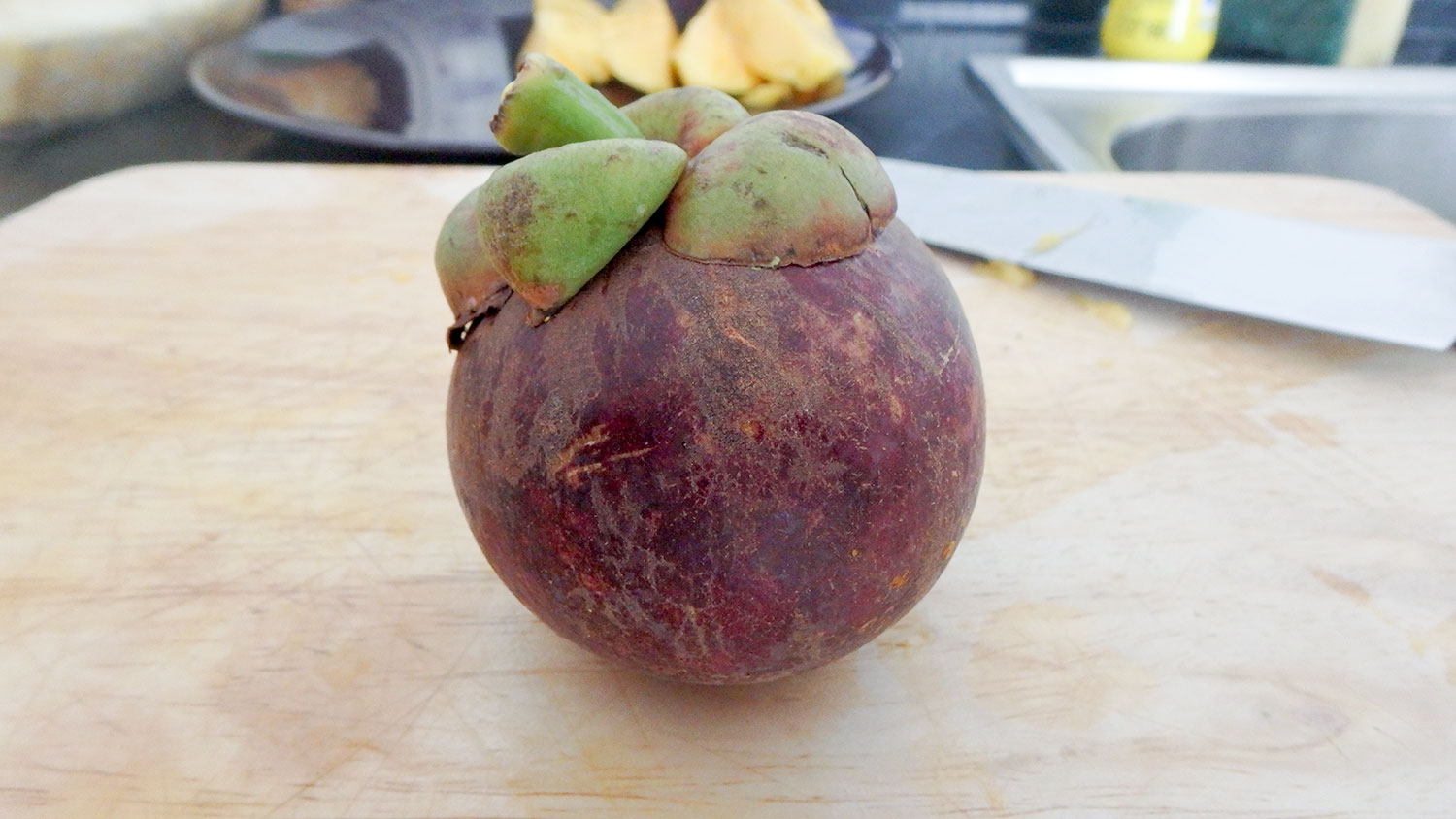
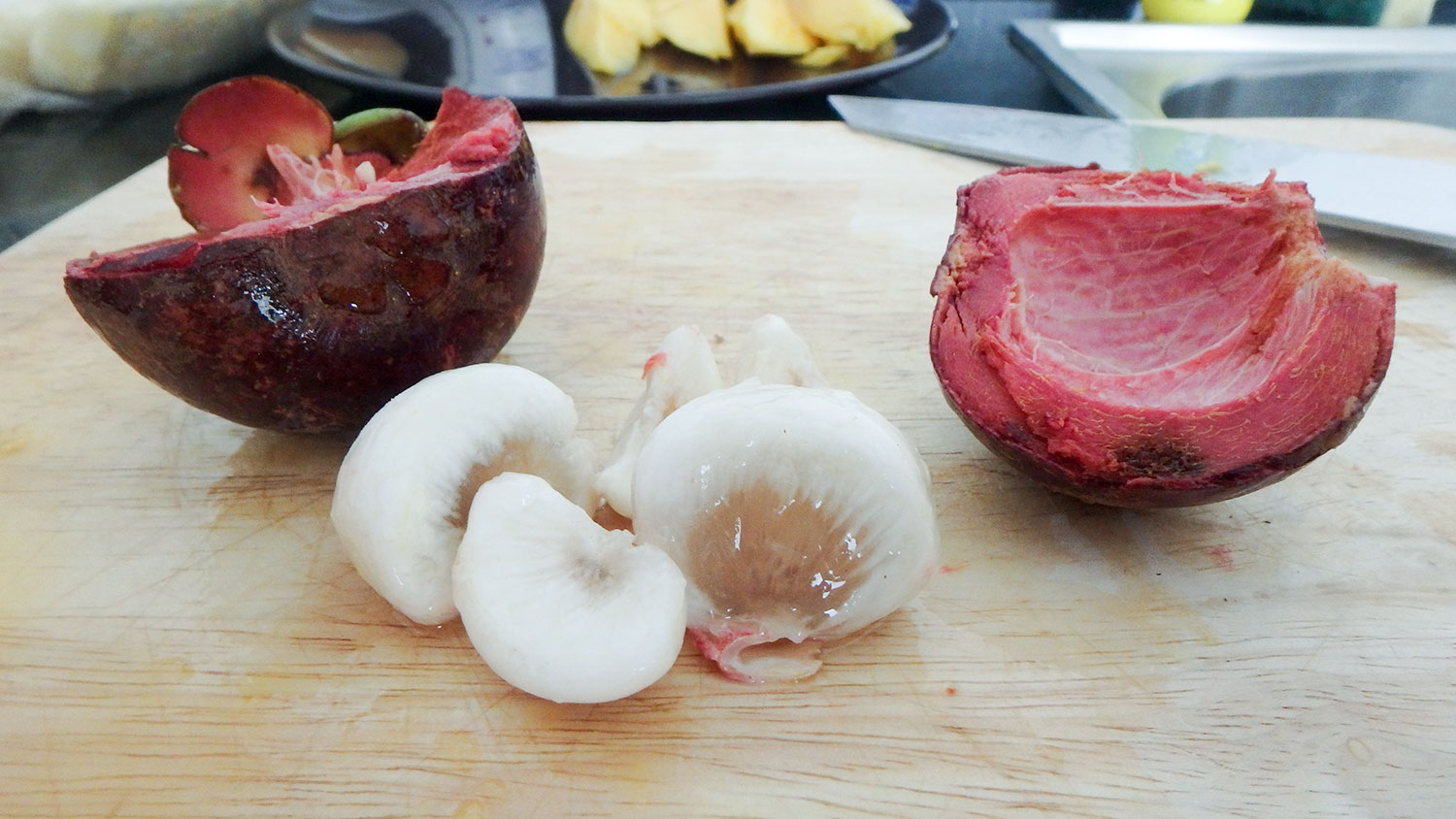
Don't eat that red stuff like I did by accident
We also tried Asian pears, pommelo, sugar apples, and papaya. Asian pears were the best of the lot, having the texture of an apple, but the taste of a pear. There were generic Asian pears, snow pears, and sweet gong pears. Sweet gong are the best.
The Mango
I've saved the best for last. Everyone "knows" that mangoes are awesome, but before this experience, I never appreciated just how much depth there is to this simple fruit. Despite my bias towards bananas, even I have to admit that the mango is significantly more profound in terms of variety, flavor, and texture.
Even though mangoes aren't technically in season right now, they were the highlight of our fruit plate every meal. We would eat three or four per day.
Our local Makro sold four varieties: tawai dueng krow, green delicious (aka emerald), varun, and namdokmai. Each variety was distinctive in terms of its ripening profile, skin and flesh color, texture, and taste. I could talk at length about the qualities of each, but I want to bring special attention to the namdokamai.
The namdokmai is special. It has a yellow-greenish skin, which changes to all yellow as it ripens, and its flesh is bright yellow. The flavor is distinctively tart, like that of a lemon. If you cut too early, the tartness is overpowering and impossible to overcome. If you time the ripeness just right, however, it's a taste explosion. The tartness is perfectly balanced by the sweetness and neither of us has ever had anything else like it. Our first reaction was just like that episode of Seinfeld. Per the internet, the namdokmai variety is native to Thailand, so try if you ever visit.
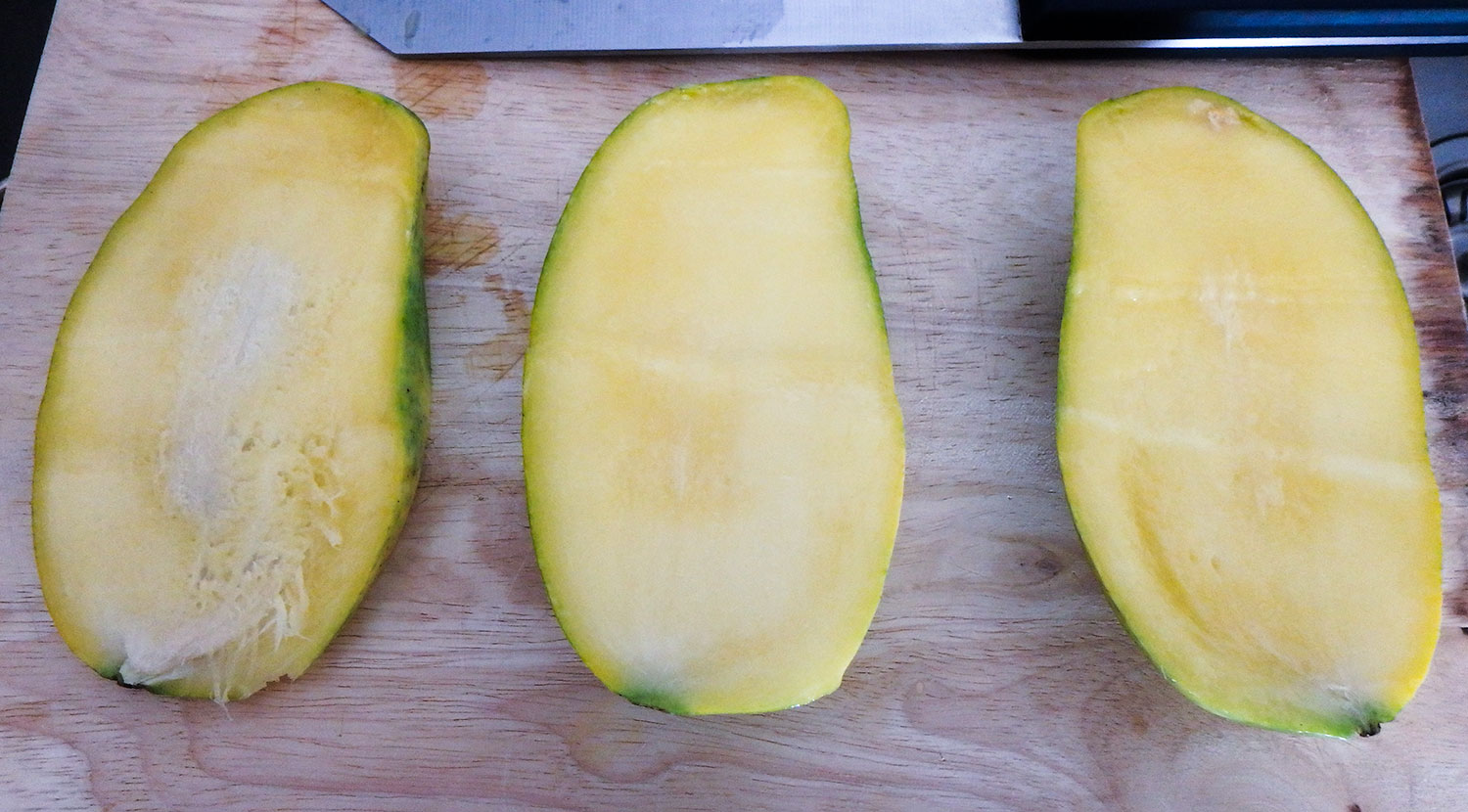
The yellow flesh of the namdokmai
And with the namdokmai mango, I now conclude this little treatise on fruit.
Lifestyle
Because we were staying in Lamai for an entire month, we decided to hunt for a deal. Using Airbnb and Tripadvisor, we toured a variety of properties, including both hotels and apartments. It was a fun exercise for me given my real estate bent. The hoteliers and landlords were adamant that August is "peak season," so we had to play a little hardball in cutting deals, but they always caved and offered some degree of discount. The hotels were able to offer surprisingly drastic discounts on monthly rates compared to the apartments, believe it or not.
Old habits die hard and I couldn't help myself from going after the "best value," even if it wasn't the least expensive. We rented an apartment located in a compound called Tropical Seaview Residence. Our "superior" (the least expensive unit) had a bedroom, living room, balcony with seaview, aircon, and a Western-style bathroom.
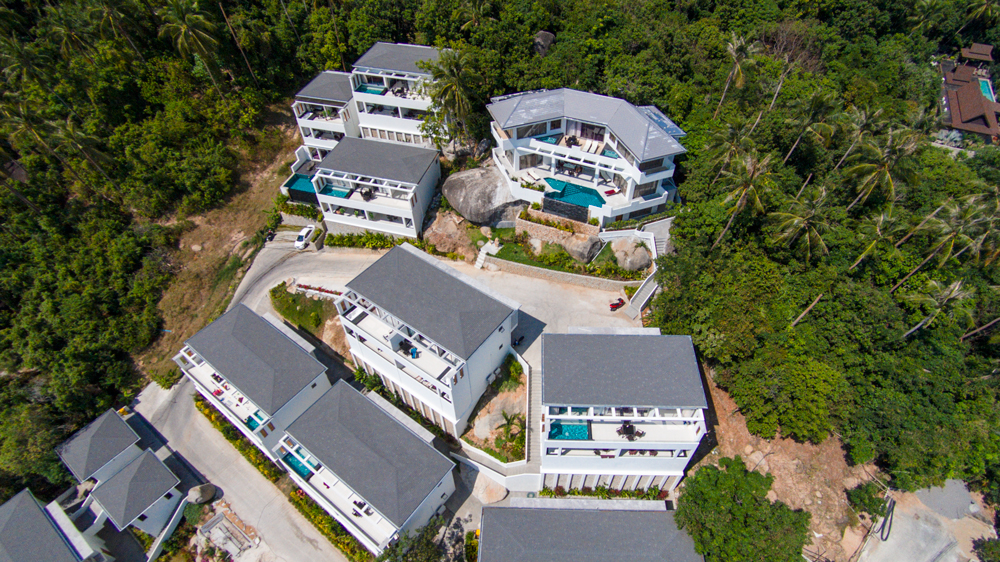
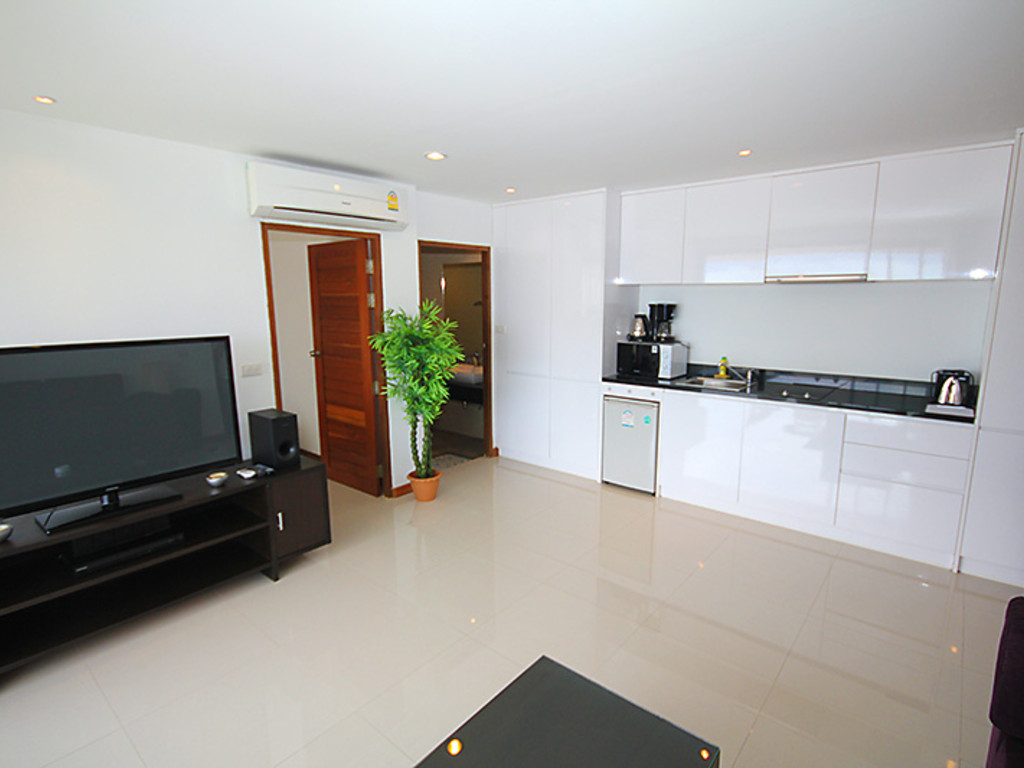
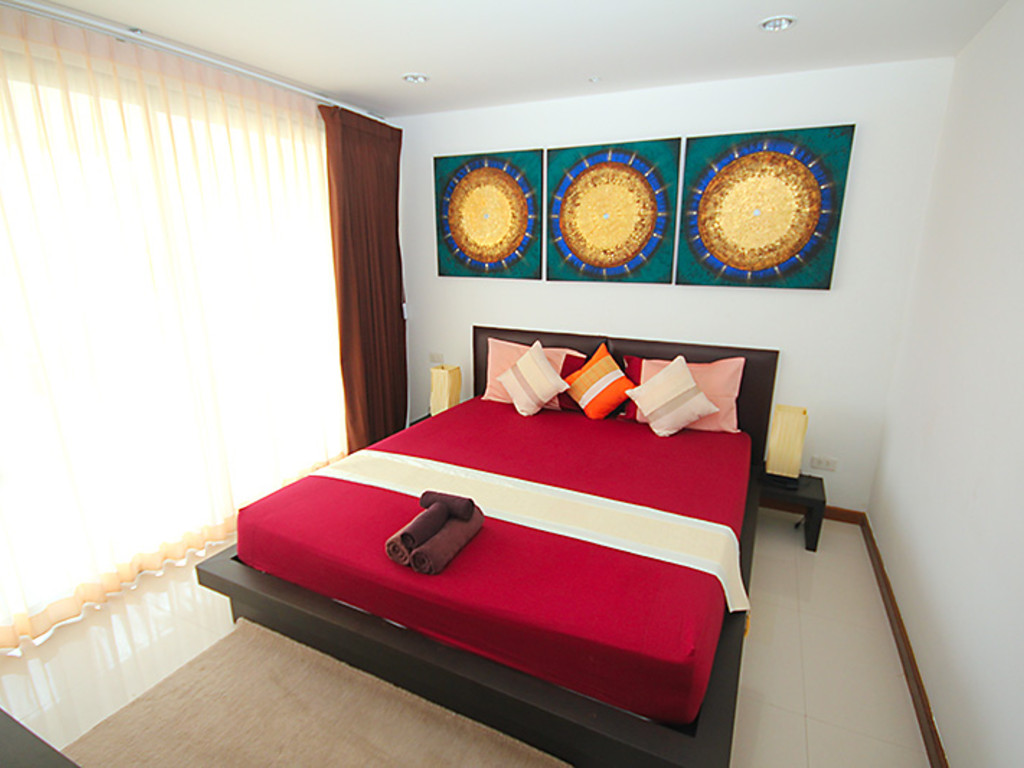
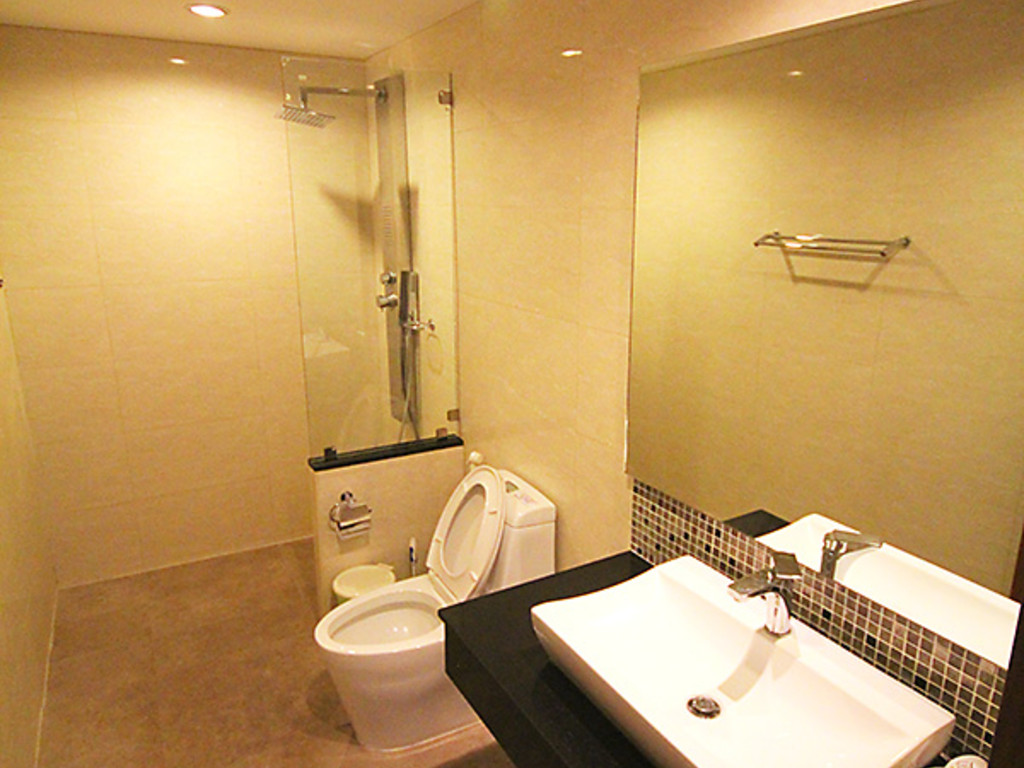
Kind of like a Thai version of The Chateau... like I said, old habits die hard.
I had buyer's remorse for all of a half day. Then we cooked a delicious, but healthy meal, ate it on our balcony overlooking the ocean, and never thought twice about the decision. The apartment was laughably inexpensive by American standards, we saved a ton of money by cooking (and it was healthier), and we were very happy.
Our daily life quickly fell into a routine which revolved around our morning and afternoon workouts. Here's what a typical weekday looked like.
| Time | Activity |
|---|---|
| 6:00 AM to 7:00 AM | Wake up, have some coffee, read emails |
| 7:00 AM to 9:00 AM | Morning workout |
| 9:00 AM to 9:30 AM | Shop at Makro |
| 9:30 AM to 10:00 AM | Cold shower, cool down |
| 10:00 AM to 11:00 AM | Breakfast |
| 11:00 AM to 4:30 PM | Read, write, chill, lunch |
| 5:00 PM to 7:00 PM | Afternoon workout |
| 7:00 PM to 7:15 PM | Cool down, enjoy fruit smoothie |
| 7:15 PM to 7:45 PM | Cold shower, cool down |
| 7:45 PM to 9:00 PM | Dinner |
| 9:00 PM to 10:00 PM | Watch something or read |
| 10:00 PM to 6:00 AM | Sleep like a rock |
To some people, this might sound like the lamest international travel ever, but we loved it. This update is already too long, so I'll need to save a detailed discussion of our (current) travel philosophy for upcoming posts, but for now, suffice it to say that we consider our trip a sabbatical. While fun and adventure are important to us, they're not the only considerations. We're also about personal development. The past month represents an experience that would never have been available to us in the "real world" and we have absolutely no regrets.
On the weekends, we'd explore the island a little, but for the most part we typically went to the beach, got massages, read, write, cooked, and rested. Here are some miscellaneous photos of the month.
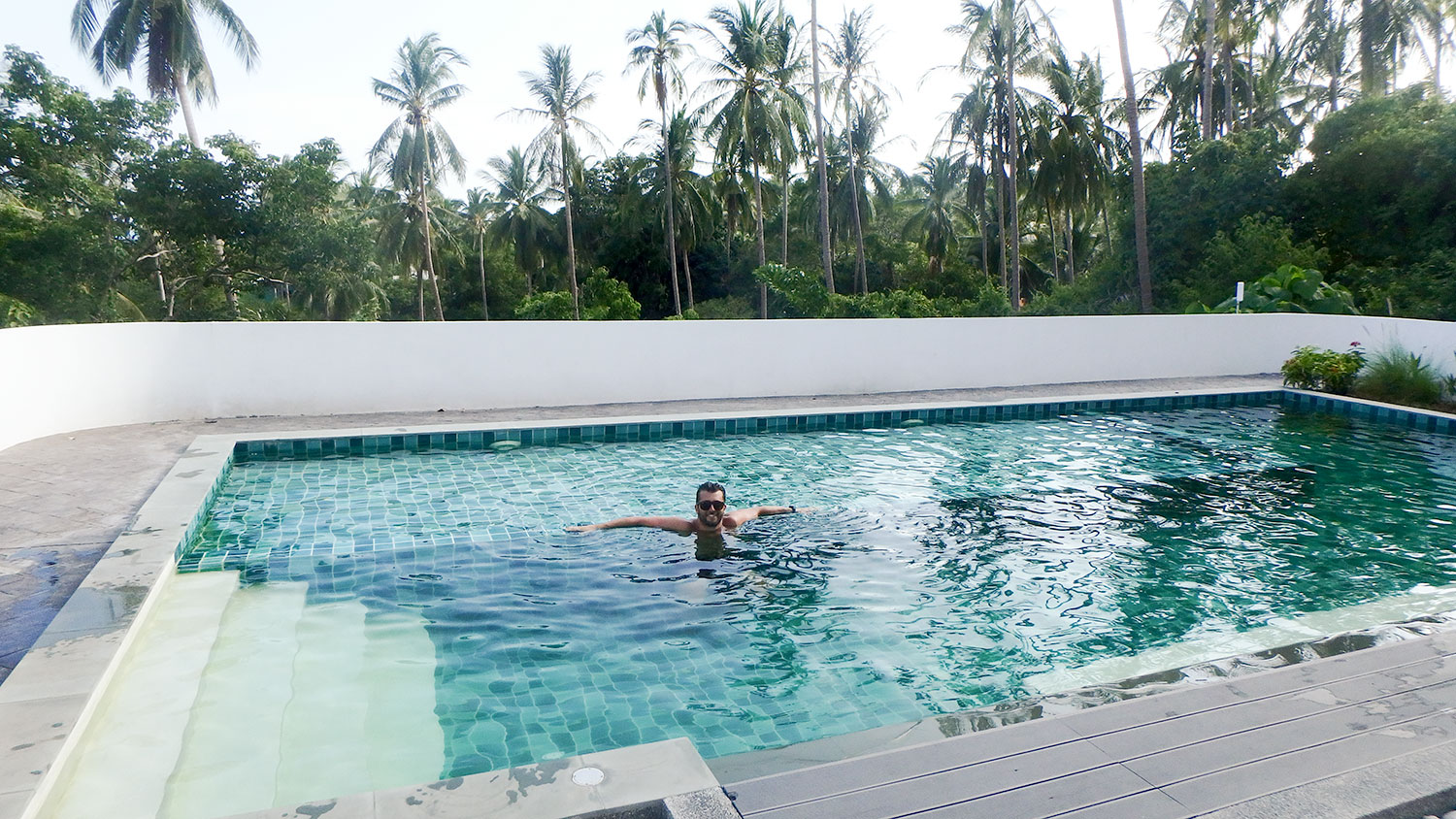
The big pool in our complex
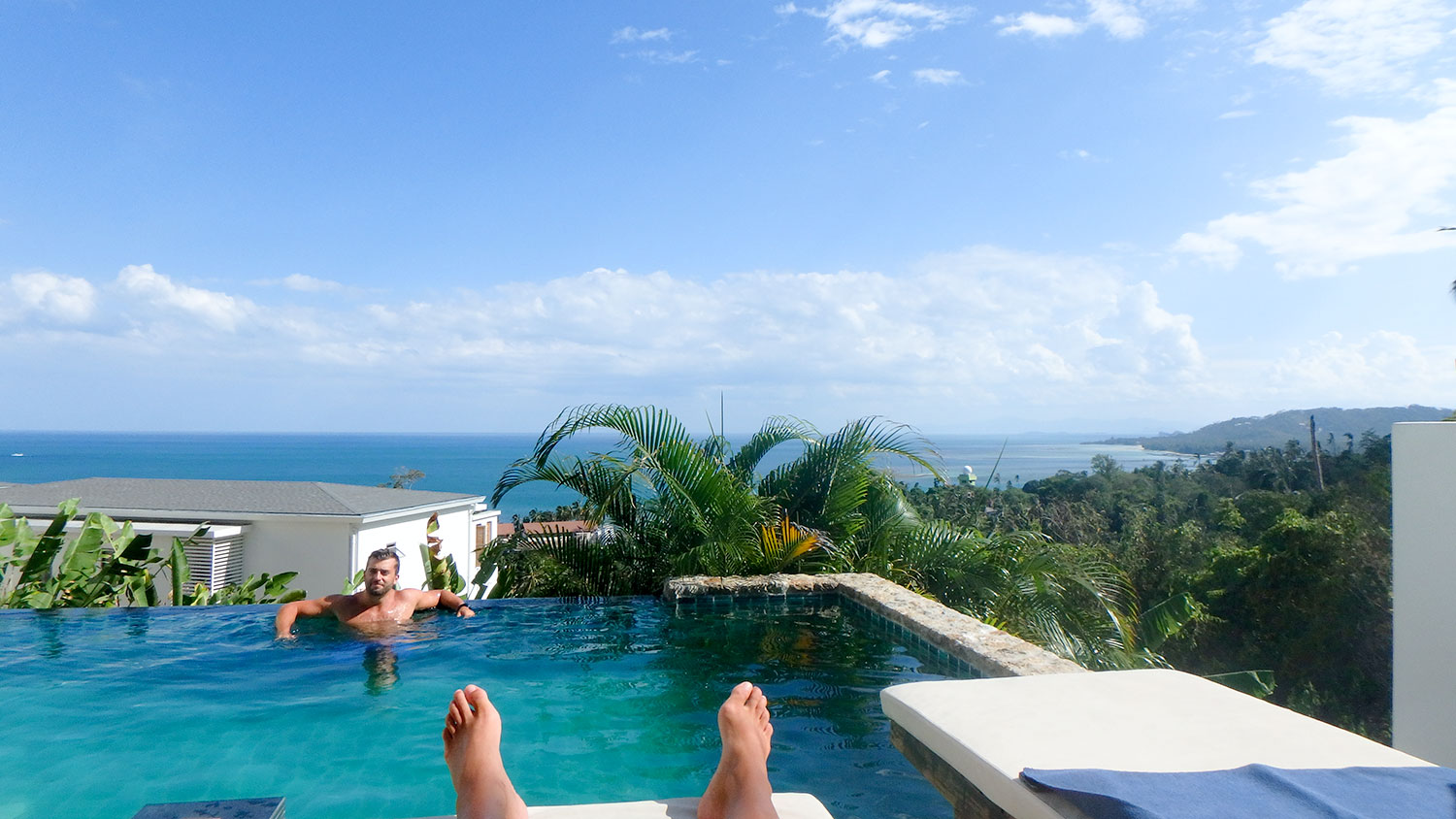
The little pool with the better view in our complex
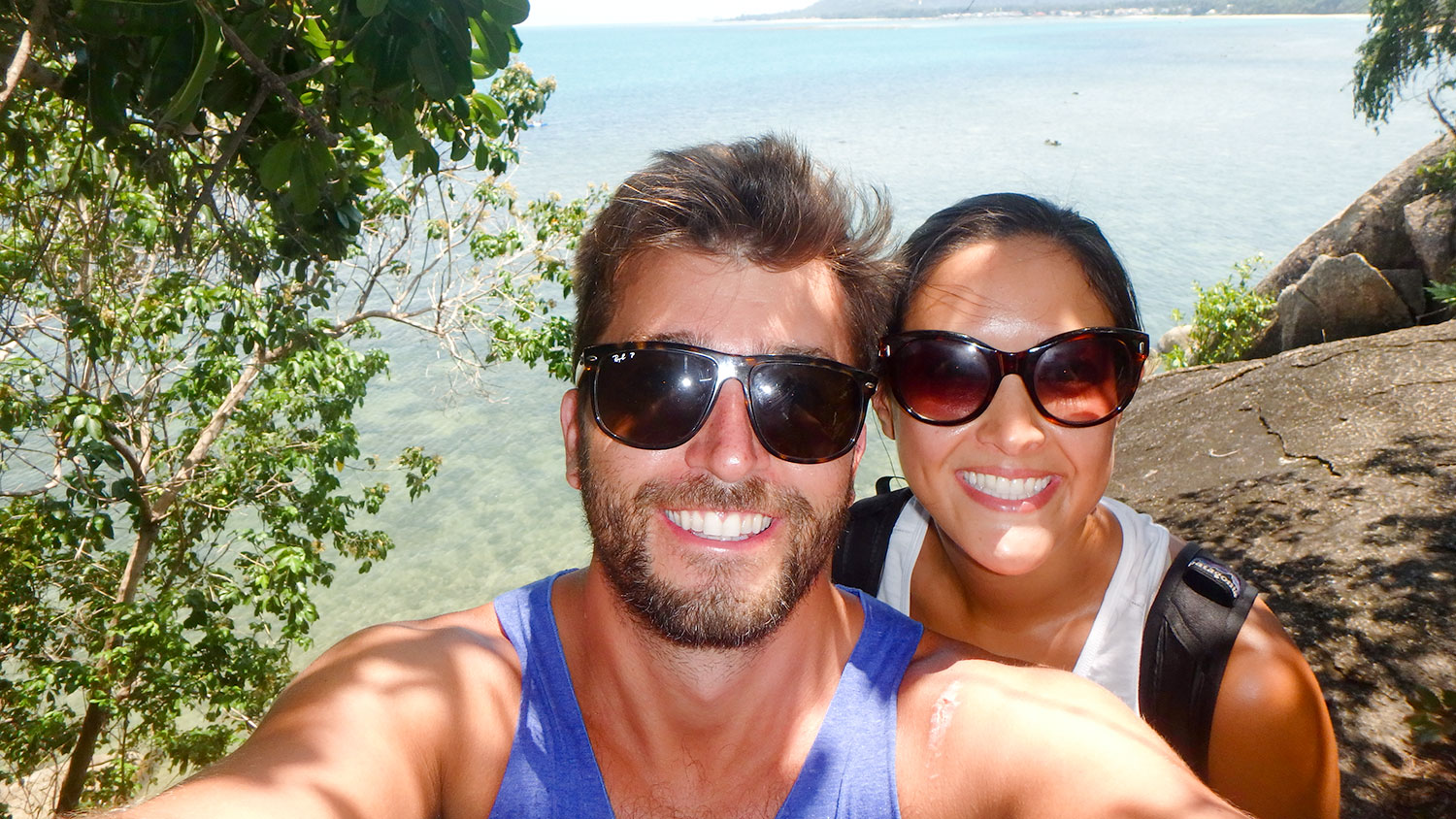
Cheesin'
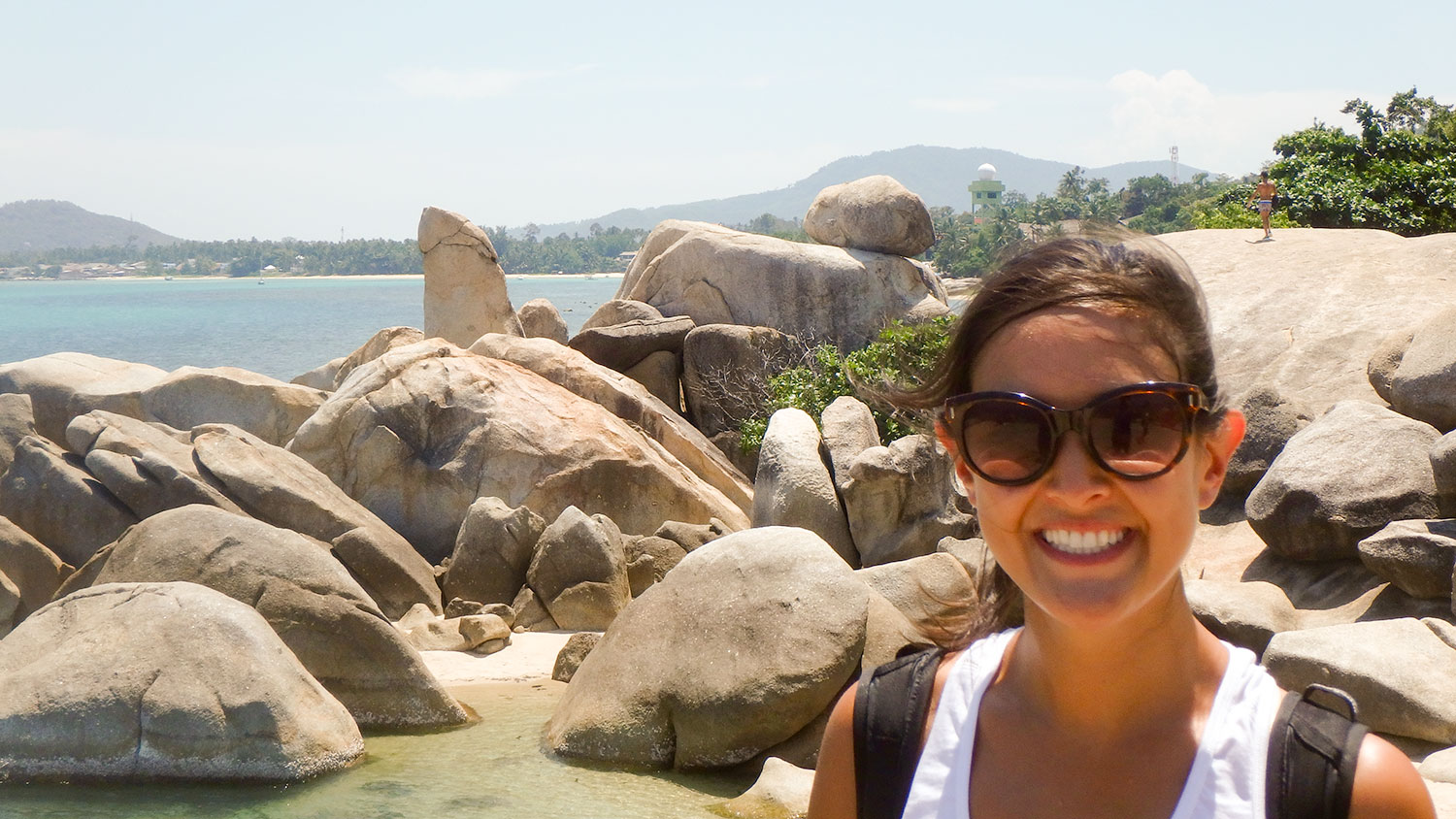
The "grandfather" rock of Hinta Hinyai (translated to grandfather and grandmother)
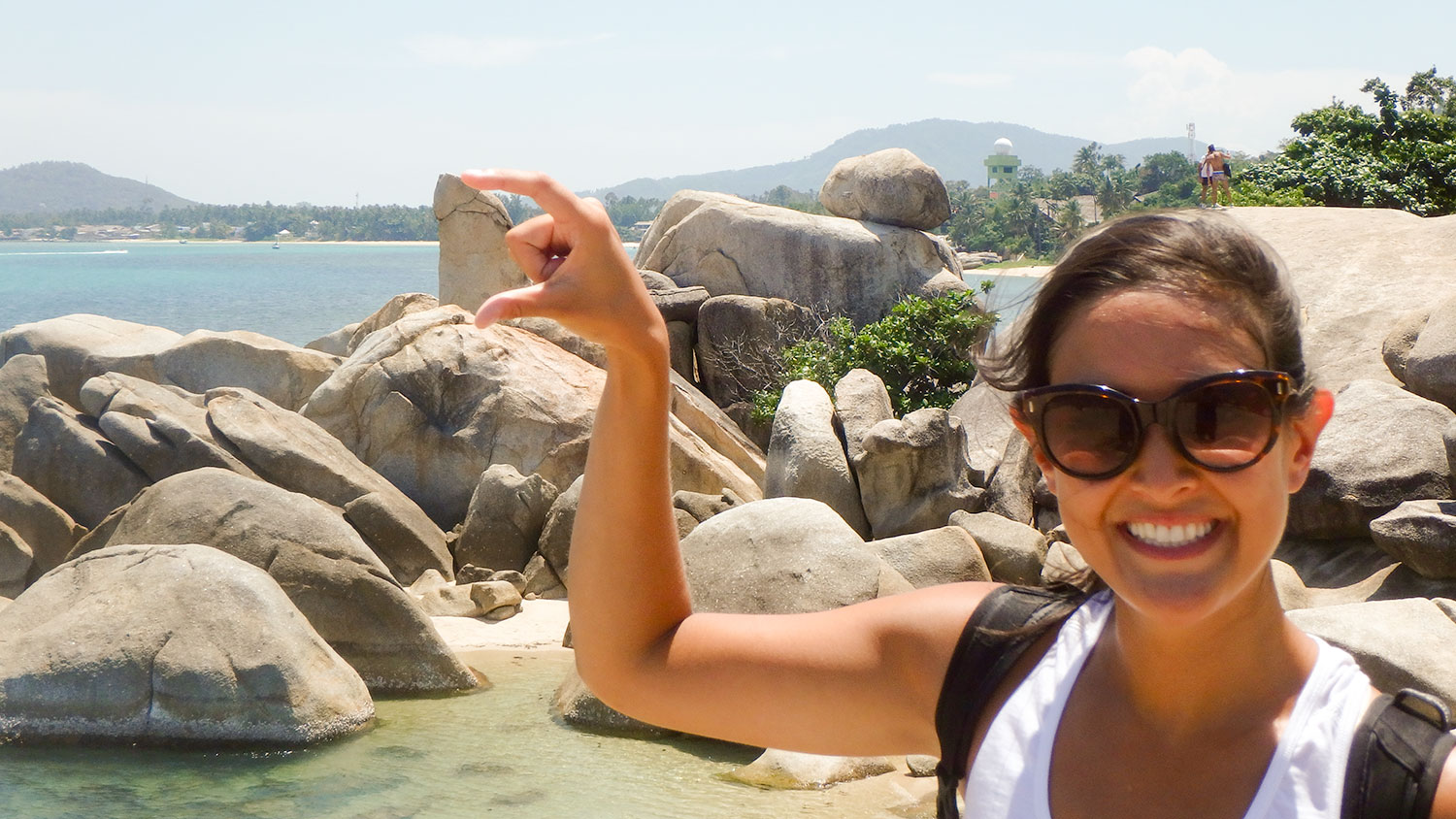
Not pictured: the grandmother rock. You can see it here.
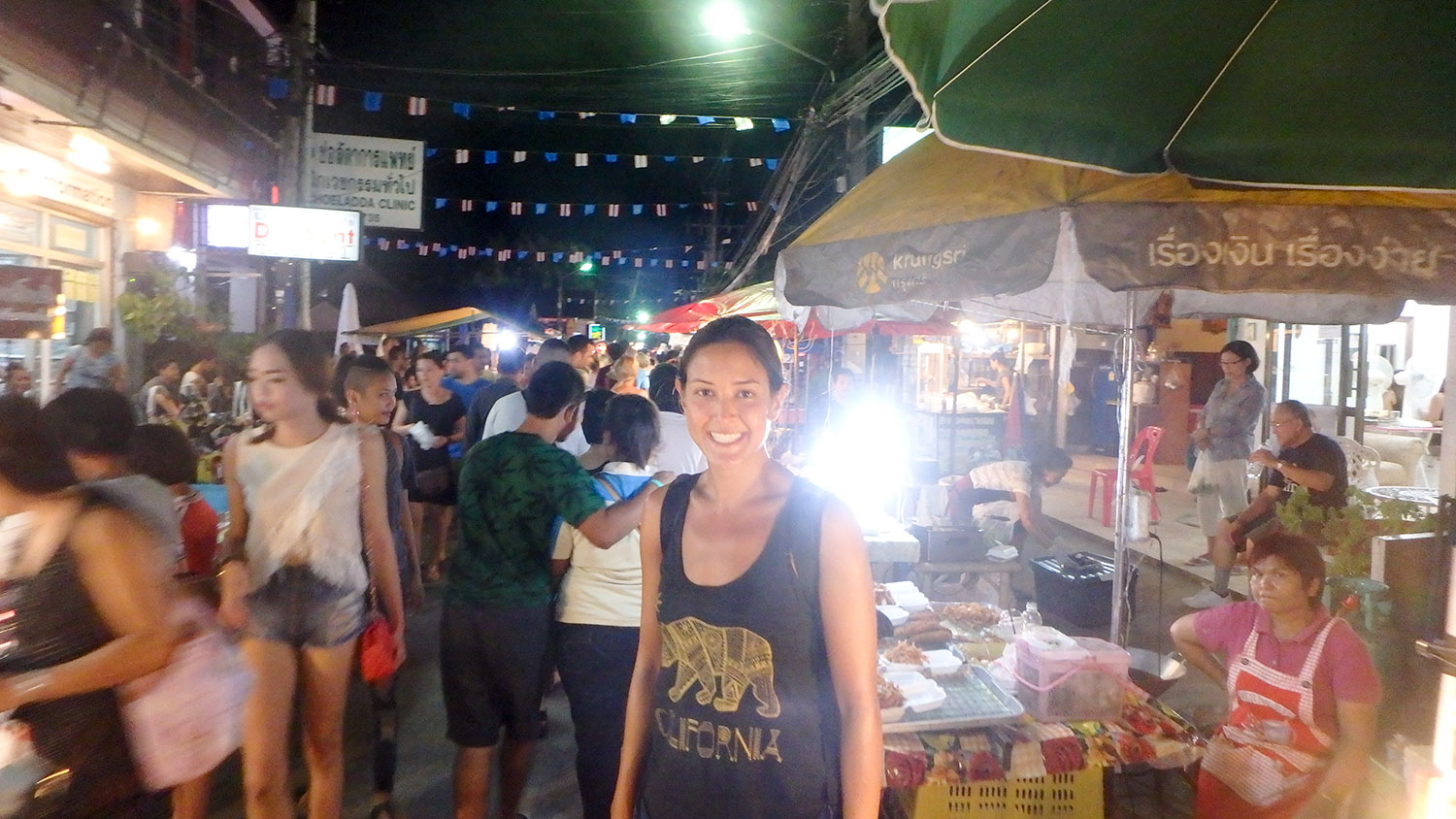
Meghan at the Lamai Night Market
Results
Alright, alright. If you've made it this far, you're probably curious about what kind of results are possible if for a month you:
- Workout four hours a day under the guidance of a professional trainer
- Eat nothing but fresh meat, fish, fruit, and vegetables
- Drink only water and some coffee (no alcohol)
- Sleep a lot
- Soak up loads of vitamin D
Let me start out by saying that I subscribe to a long-term view of fitness. In the scheme of things, four weeks isn't that much time. We weren't expecting life-changing results -- we just wanted to jump-start the fitness component of our sabbatical and take things to the next level.
With that disclaimer out of the way, now let me say: holy shit.
Never in my wildest dreams did I imagine the results after four weeks would be so dramatic.
Let's talk about fitness first.
I don't think I was able to finish a single workout the first week. During some of the workouts, I thought I might have a heart attack and die. Outside of the workouts, my body went into some sort of shock in which I retained massive amounts of water and my arms swelled to gigantism proportions (I wish we had taken a photo of this). Both of us were so sore we could barely move for a week.
By the end of the month, we were finishing workouts, sometimes with energy to spare. They were still grueling, and we still have much room for improvement, but at least we were no longer laid up for the next four hours in recovery. The soreness went away. You might even say that we began to enjoy the intensity.
I personally experienced a number of breakthroughs. For instance, those of you who know me well know just how much I loathe running and swimming. In tenth grade, in a 1984 book report, we had to write what our personal Room 101 would look like. I described mine as running on a treadmill. At Lamai Fitness, both Meghan and I set our personal bests, running farther and longer than we ever have in our lives.
The swimming accomplishments were even more fulfilling. In mid-July, I couldn't swim freestyle for 100 meters without seizing up. I know this for a fact because we had a swim test for scuba diving. Honestly, I'd go as far as to call swimming a bit of a personal phobia prior to this month. In quiet moments while coastal sailing, I'm often haunted by visions of going overboard and not being able to make it a few miles to shore. Now we've swum 4 kilometers in open water a few times, ending with gas in the tank. I'm not saving lives in the ocean or setting any speed records here, but this new-found swimming confidence is game-changing for me.[^n]
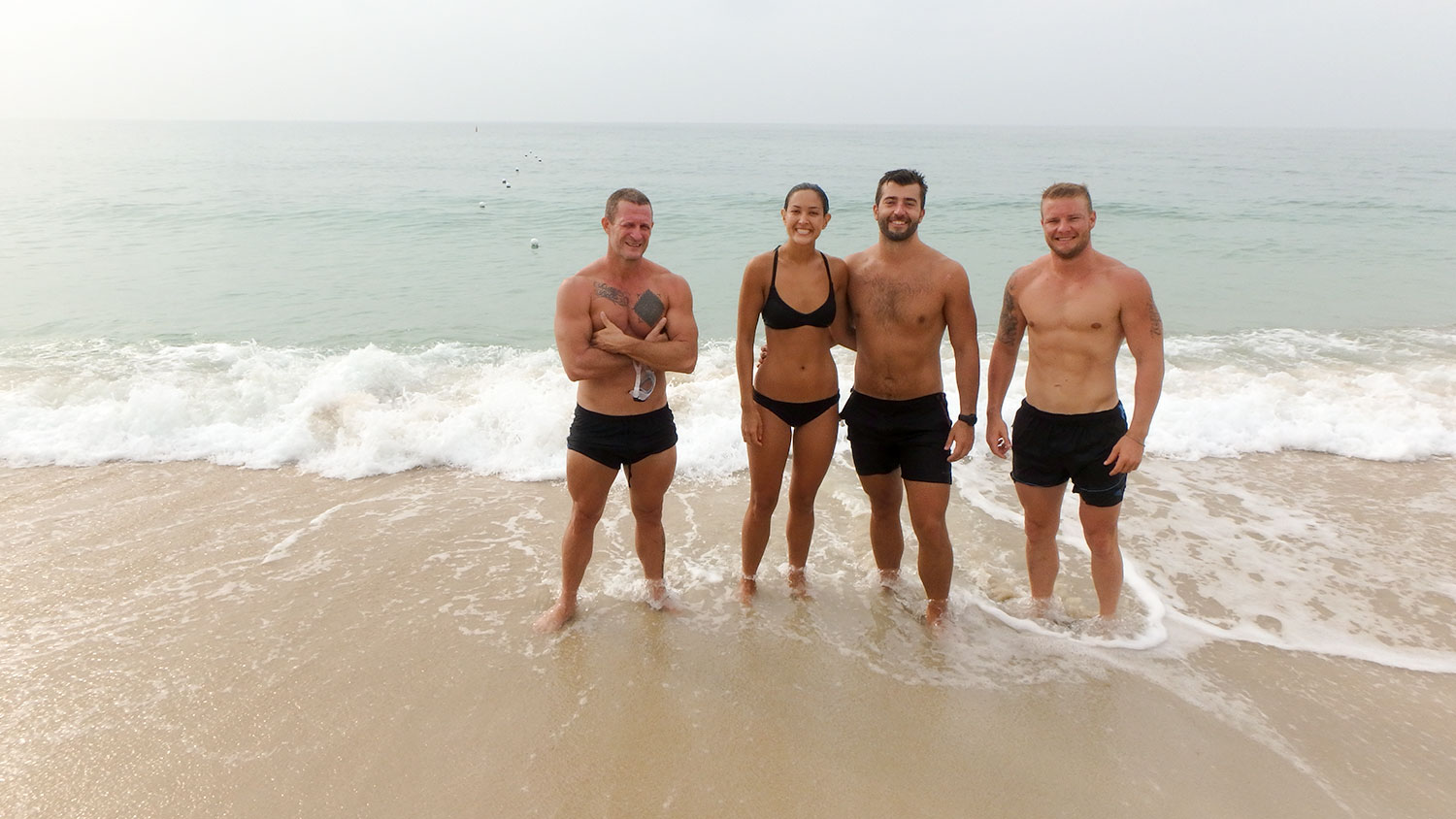
After a morning session of swim sprints. That little speck in the distance, beyond the white buoys, is the red flag we'd swim to as a warm up.
In terms of body composition and weight, the numbers don't really tell the whole story. At the beginning of the month, I weighed 95.5 kilograms with 23.6% body fat (measured using a bioimpedance scale). At the end, my statistics were 92.4 kilograms with 20.4% body fat. That means I lost 6.8 pounds of scale weight -- down 7.3 pounds of fat and up 0.5 pounds of lean mass.[^n]
Like I said, these statistics don't really paint an accurate picture. In person, we have literally shed fat and toned up. Meghan and I see each other every day and we're still taken aback by how different the other looks (and feels). I wish I had taken circumference measurements to maybe objectively demonstrate the transformation better. But trust me when I say the results have significantly exceeded every rational expectation of mine for what was possible in four weeks.
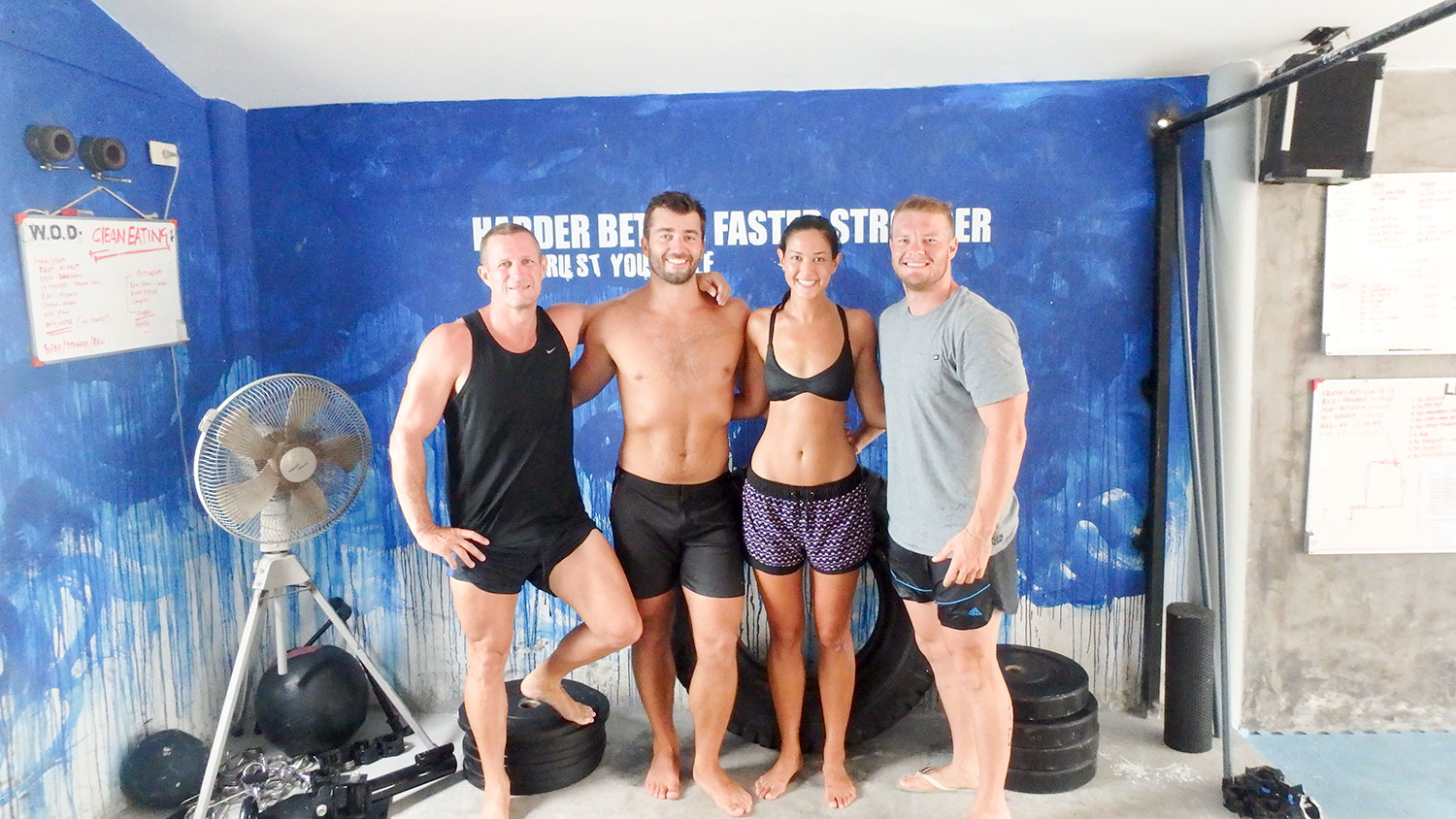
Meghan and me with Billy and Mike
Fitness Going Forward
One concern that's on our minds these days is maintaining -- and hopefully building upon -- these results. It feels like we just worked so hard to reach some higher plane of physical fitness and now it's abruptly coming to an end. For me, my body has finally started to adapt to handling this ridiculous volume. Now I am beginning to build strength whereas before it was all about stamina. For Meghan, this experience uncovered a latent athleticism and Billy is urging her to start training for a half Ironman. She casually ran a rugged 21 kilometers this morning in 2:06.[^n] And then she completed a two hour leg day during the afternoon.
It's hard to workout when you're traveling, even when you move slowly from place to place like we do. We have a couple ideas, but we're going to need to get creative, so if you know any good resources for programming challenging workouts while on the road, please let us know.
Until we come up with something better, we're going to focus on doing 100 burpees, 100 push-ups, 100 sit-ups, and 100 air squats each morning. Then we'll try and devise some other activity at least every other day, be it a run, swim, bike, or bodyweight Crossfit WOD.
More difficult than programming, however, is keeping up the intensity. We're also very open to suggestions in that department if you have any.
Next Up
Leaving Koh Samui and Lamai Fitness is bittersweet, but it is time to start the next chapter of our journey. We just awakened our bodies. Now we turn attention to our minds.
We're going off the grid starting on September 1st for 10 days. We'll resurface in Chiang Mai on September 12th.
As always, we'd love to hear from you!
